- 0 No item in your cart
- The magazine

Current issue
- All the issues
- My magazines
- Technical specifications
- Multihull of the Year
- Classified Ads
- Destinations
- Online store
- All the magazines
- Subscriptions
- Accessories

An excellent all-purpose platform, the Leopard 43 meets all or almost all programs with a budget that remains reasonable. Strong and well thought out, this catamaran is the perfect base for an upgrade or a refit. A family seeking to head off blue water cruising will find what they’re looking for aboard this boat.
The long outboard chines are characteristic of this model designed by Alex Simonis.
Equipped with a slightly more powerful sail plan and folding propellers, the Leopard 43 can get going very nicely.
The Leopard 43 is an evolution of the 42, with a rigid bimini and longer sugarscoops.
1/ The curvy design contrasts with the taut lines that have become the norm today – but how long will that last?
3/ ...with the exception of the owner’s berth in the three-cabin version.
Practical info
- Builder : LEOPARD CATAMARANS
- Finance your Leopard 43
- Articles about the Leopard 43
- Available in issue # 185
Boat Test price 3.00 € Inc. tax

Add several tests to your cart
and get an extra discount!
The Leopard 43 was an evolution of the 42: the specifications are clearly aimed at the charter industry, with the 4-cabin version operated under the name Moorings 4300, but a Leopard version with three cabins (ie. with the famous Owner’s hull) was also available, initiating a combined charter/owner positioning. At the front of the nacelle, no forward door – this first appeared in 2010 with the 43’s replacement, the Leopard 44.
Balsa and honeycomb
The Leopard 43 is built in a balsa/glass/polyester sandwich. Only the deck-hull joins, the chines and the skeg keels are in monolithic. The deck/hull connections are glued, bolted, and laminated at strategic points. The bulkheads are glued to the hulls. The core is made of balsa, chosen over foam because of its resistance. The yard used honeycomb structure to reduce the weight in certain non-structural parts, such as the large heads compartment bulkhead. The application is classic vacuum: gelcoat and resin are applied without spraying, which reduces the use of solvent, air bubbles, and allows better control of the thickness. The cloth is impregnated by contact, with bubbles carefully pushed out by hand to remove air and excess resin. ...
To read in full, Buy the boat test
What readers think.
Post a comment
No comments to show.
MW #197 - Oct / Nov 2024
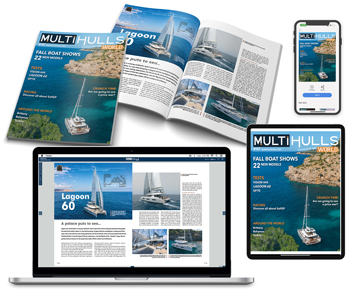
Download all the Boat Tests
Over 500 multihull tests
Boat tests from the same builder

- Leopard 40 PC

Leopard 46 PC
- Leopard 46 Powercat

- Leopard 43 PC
Place a classified ad Free of charge
on Multihulls World
Boat tests from the same range

- Seawind 1370

- Nautitech 48 Open
Classified ads

Woods Flica 35
Bosgraaf 15m trimaran, minicat 310.

Nautitech 48 0pen Available
Vous avez ajouté " " à vos favoris., vous avez supprimé " " de vos favoris., in order to add this article to your favorites, please sign in..
Did You Know That We Offer Contract to Closing Services? Click Here to Find Out More.
Need Marine Financing? Apply Here With Our Partner, First Approval Source
- Catamaran Interviews
- Catamaran Reviews
- Buying Advice
- Selling Advice
- Woods Design Advice
- Admiral 38
- Admiral 40
- Admiral 50
- Americat 3014
- Antares 44
- Aquila 44
- Aquila 48 Power Catamaran
- Aventura 37
- Balance 442
- Balance 482
- Balance 526
- Bali 4.0
- Bali 4.1
- Bali 4.2
- Bali 4.3
- Bali 4.4
- Bali 4.5
- Bali 4.6
- Bali 4.8
- Bali 40 Catspace
- Bali 5.4
- Bali Catsmart
- Beneteau Blue II
- Broadblue 346
- Broadblue 38 Prestige
- Broadblue 385
- Broadblue 435
- Broadblue 46
- Rapier 400
- Rapier 550
- Catalac 10M
- Catalac 11M
- Catalac 12M
- Catalac 8M
- Catalac 900
- Catalac 9M
- Catana 381
- Catana 39
- Catana 401
- Catana 40S
- Catana 411
- Catana 42
- Catana 42 S
- Catana 431
- Catana 44
- Catana 471
- Catana 50
- Catana 521
- Catana 531
- Catana 55
- Catana 581
- Catana 65
- Catathai 44
- Chris White
- Chris White 48 Voyager
- Chris White 55
- Condor 40
- Contour 34
- Corsair F28 R
- De Villiers
- Dean 365
- Dean 400
- Dean 440
- Dean 500
- Dix DH550
- Dolphin 380
- Dolphin 460
- Edel 35
- Endeavour 30
- Endeavour 35 Victory
- Endeavour 36
- Endeavour 44
- Endeavour 44 TrawlerCat
- Endeavour 50 Pilothouse Trawler
- Excess 11
- Excess 15
- F-41
- Fastback 43
- Fastcat 445
- Fisher 28
- Fisher 32
- Fortuna 36 Island Spirit
- Fortuna 401 Island Spirit
- Fountaine Pajot
- FP 32 Maldives
- FP 35 Tobago
- FP 36 Mahe
- FP 37 Antigua
- FP 38 Athena
- FP 39 Fidji
- FP 40 Isla
- FP 40 Lavezzi
- FP 40 Lucia
- FP 40 MY
- FP 40 Summerland MY
- FP 41 Lipari
- FP 42 Astrea
- FP 42 Venezia
- FP 43 Belize
- FP 44 Helia
- FP 44 Orana
- FP 45 Elba
- FP 46 Bahia
- FP 46 Casamance
- FP 48 Salina
- FP 50 Saba
- FP 56 Marquises
- FP 57 Sanya
- FP 58 Ipanema
- FP 60 Eleuthera
- FP Saona 47
- Fusion 40
- Gemini 105
- Gemini 3000
- Gemini 3200
- Gemini 3400
- Gemini Freestyle 37
- Gemini Freestyle 399 Power
- Gemini Legacy 35
- Grainger 420 Mystery Cove
- Gunboat 55
- Hirondelle 7M
- HopYacht 30
- Island Packet
- Island Packet Cat 35
- Kennex 420
- Knysna 440
- Knysna 480
- Knysna 500
- Knysna 550
- Lagoon 35
- Lagoon 37 TPI
- Lagoon 380
- Lagoon 39
- Lagoon 40
- Lagoon 400
- Lagoon 410
- Lagoon 42
- Lagoon 42 TPI
- Lagoon 420
- Lagoon 421
- Lagoon 43 PC
- Lagoon 44 Power Cat
- Lagoon 440
- Lagoon 450
- Lagoon 46
- Lagoon 470
- Lagoon 50
- Lagoon 500
- Lagoon 52F
- Lagoon 55
- Lagoon 560
- Lagoon 570
- Lagoon 620
- Lagoon Seventy 8
- Lagoon Sixty 7
- Leeuwin 42
- Leopard 38
- Leopard 39
- Leopard 39 PowerCat
- Leopard 40
- Leopard 42
- Leopard 43
- Leopard 44
- Leopard 45
- Leopard 45 Classic
- Leopard 46
- Leopard 46 Lion PowerCat
- Leopard 47
- Leopard 47 PowerCat
- Leopard 48
- Leopard 50
- Leopard 51 PowerCat
- Leopard 53 PowerCat
- Leopard 58
- Lidgard 73 Executive
- Looping 50
- Maine Cat 30
- Maine Cat 38
- Maine Cat 41
- Manta 40
- Manta 42
- Matrix 450 Vision
- Matrix 760 Silhouette
- Maverick 400
- Maverick 420
- Maverick 440
- Moxie 61
- Nautitech 40
- Nautitech 40 Open
- Nautitech 44 Open
- Nautitech 442
- Nautitech 46 Open
- Nautitech 47
- Nautitech 47 Power
- Nautitech 475
- Nautitech 65
- Neel 45
- Neel 47
- Outremer 40
- Outremer 45
- Outremer 50 Standard
- Outremer 55
- Outremer 5X
- PDQ 32
- PDQ 36
- PDQ 42 Antares
- Privilege 37
- Privilege 39
- Privilege 42
- Privilege 43
- Privilege 435
- Privilege 45
- Privilege 465
- Privilege 48 Transcat
- Privilege 482
- Privilege 495
- Privilege 510
- Privilege 65
- Privilege Serie 5
- Prout 31 Quest
- Prout 33 Quest
- Prout 34 Event
- Prout 35 Snowgoose
- Prout 37 Snowgoose
- Prout 37 Snowgoose Elite
- Prout 38
- Prout 38 Manta
- Prout 39 Escale
- Prout 45
- Prout 46
- Royal Cape 45
- Royal Cape 500 Majestic
- Royal Cape 530 Majestic
- Sailcraft 30 Iroquois
- Sailcraft 32 Comanche
- Sailcraft 35 Cherokee
- Sailcraft 41 Apache
- Sailcraft 44 Apache
- Scape 39
- Wildcat 350
- Seacart 30
- Seawind 1000
- Seawind 1160
- Seawind 1200
- Seawind 1260
- Seawind 1600
- Simpson 48
- Solaris 36 Sunrise
- Solaris 36 Sunstar
- Solaris 42
- St Francis 44
- St Francis 48
- St Francis 50
- Stealth 11.8
- Sunreef 60
- Sunreef 62
- Sunreef 70
- Sunreef 74C
- Sunreef 82 DD
- Sunreef 88 DD
- Switch 51
- Switch 55
- TRT 1200
- Heavenly Twins 26
- Ocean Twins 38
- Vaan R5
- Vision 444
- Voyage 380 Maxim
- Voyage 400 Norseman
- Voyage 430 Norseman
- Voyage 440
- Voyage 450 Cabriolet
- Voyage 47 Mayotte
- Voyage 480
- Voyage 500
- Voyage 580
- Voyage 590
- Kronos 45
- Wharram 38 Tiki
- AMI 320 Renaissance
- Woods 22 Wizard
- Woods 35 Banshee
- Woods 35 Flica
- Woods 36 Scylla
- Woods 36 Vardo
- Woods 38 Transit
- Woods 40 Meander
- Xquisite X5
- Xquisite X5+
“SV Tusitala” Leopard 43 Review and Owner Interview
- Post author By Richard
- Post date December 27, 2020
- No Comments on “SV Tusitala” Leopard 43 Review and Owner Interview

Kevin owns a 2007 Leopard 43 named S/V Tusitala which he purchased through the for sale by owner listings on www.CatamaranSite.com . He talks to us about the Leopard 43 and also more general topics about sailing with five kids, why the ocean is like a desert, and his thoughts on how to prepare for a world cruise. You can follow him on his YouTube channel or website or blog all under the handle “Seven on the Sea.” Thank you so much to him for participating in our series of interviews with catamaran owners.
Executive Summary
- Sailing with his wife and five kids ages 6 to 18 on a Leopard 43
- Sailing out of San Diego and preparing to head offshore
- Tusitala is the nickname of author Robert Louis Stevenson and means “teller of tales.”
- Chose Leopard 43 because of space and affordability. He considered monohulls but accommodations were smaller and did not like heeling. Used to sailing catamarans his whole life.
- Four head charter version and he would like to convert one head to be an additional pantry area with freezer for long term cruising.
- Ideal cruising grounds would be Bahamas. Very few Leopards on Pacific coast of USA.
- Would like a bigger boat for more space but costs rise exponentially with boat length.
Who is your crew?
My crew is just my family: my wife Katie and my five kids. My oldest is 18. My youngest is six. Our oldest is our most avid sailor and he’s probably the most competent.
I grew up in Amarillo Texas and learned to sail at boy scout camp and and so our family has been sailing small catamarans for a long time. We own a beach catamaran as well and so my all my teenage kids know how to sail and have spent quite a bit of time sailing on small bodies of water.
We just bought Tusitala in January.
Does each kid have a job onboard?
As far as jobs go, owning a boat is 90 percent like cleaning the boat and and like fixing it and a little bit of sailing. They’re always helpful.
Where is Tusitala right now?
Our boat right now is moored in San Diego and we live in Utah and we’re preparing over the next couple years to take some time off and go cruising. We don’t have a whole lot of experience, and so we’re sort of building our our resume up.

I’ve done a little bit of offshore sailing and and over the past year we’ve taken a handful of trips off the coast of California up to Catalina and and the Channel Islands.
I noticed on your blog you talked about the “desert of the ocean.” Can you tell us about that?
Most of our trips right now because I’m still working we’re out there trying to get experience. We’re always looking for wildlife right now. That’s one of our the things that we do the most. We do some fishing and looking for wildlife and at a certain point when you get out there you see like once you get off the continental shelf and there’s not some sort of banks and areas where there’s a lot of fish, there’s just nothing and it’s i think it’s beautiful and it’s fantastic. It’s quite a beautiful sort of peaceful lonely experience.
You’re just there with you and your family and that’s kind of one of the things that that i like about it. Taking some time to get the kids away from all their electronics and their distractions that they have and to teach the family to sort of rely on each other and build some skills of self-reliance and i think that sailing on the ocean is a really good way to do that.
Can you tell us a little bit about the name to Tusitala? It’s so unusual.
The boat was originally named Living Free. Tusitala is from what i understand it’s the the nickname given to Robert Louis Stevenson, the author. It means teller of tales and so i think for us it’s just like a platform for us to begin to craft our own sort of story.
What’s the best thing about your Leopard 43?
When we were looking for a boat we were trying to find a boat that was big enough because we have a family of seven and so there aren’t a lot of boats that really give everybody enough space to sort of have their own space.
In fact when we began to look at sailboats we were looking at monohulls. We started to look at Beneteaus and Jeanneaus. Those are some of the things that we took test sales out on and even though you could kind of squeeze in seven people there wasn’t seven people with their own space. Even Tusitala is a little smaller than I’d like to be, but it’s as big as i can actually afford to be honest .

So the primary thing that we like is that it’s is the space and the size of a catamaran. I guess it technically it sleeps like 10 and if you were to count the settee you could sleep maybe 12 but we don’t really count those and so sleeping quarters are really important for us.
We also like that it’s a catamaran after after my wife and i took out a couple of monohulls. I think our Jeanneau was a 42 footer and the Beneteau was 45 foot. We’re quite used to sailing catamarans. Healing was not something we were really accustomed to. I mean we’re used to flying holes on beach cats but that’s a different animal from just sort of healing and getting rolled around constantly.

So I love catamarans because they feel more comfortable. I’ve heard people say like they don’t feel natural when you’re sailing like a monohull, but I’ve only really sailed catamarans so they feel perfectly natural to me and i prefer the way they feel and that I and i think they’re also comfortable because they don’t heal so yeah that’s another thing we like.
What about the heads? How many do you have and are there enough for your family?
There’s actually more than we need i mean our our house has two bathrooms and our catamaran has four heads. We don’t have a huge house either our kids are accustomed to living in tight quarters sharing bedrooms and sharing bathrooms, so there’s more than i would like.

I would actually like to take out at least one of the heads and just convert it to a pantry area and that’s what our plan is for when we go cruising. We’re going to convert one area to just a complete sort of like utility closet slash pantry area where we’ll put an additional freezer a bunch of shelving for just a bunch more utilitarian storage space.
What else would you change if anything?
A couple of things. She was owned by a couple who didn’t have any kids but they had set it up for cruising pretty decently. They’ve installed a water maker and some solar panels. They installed a washer dryer combo area in in a really convenient spot and the guy was like a master woodworker so it looks very good the way he did everything.

But what i would change obviously I think that everybody says this is we we’re just going to need a whole lot more electricity. I plan to put on another probably thousand watts of solar and we’re going to be upgrading batteries. Right now she’s got a 600 amp hours of AGMs and i plan to put on about 900 amp hours of lithium. Batteries and solar will be one of the big upgrades that we do.
Then the dinghy right now it is as we because again family of seven the dinghy is a little small and very under powered, so in fact we’re in the process of buying a 13-foot dinghy with a larger motor that can push us all around.
Those are some of the updates.
I enjoyed reading your adventure going out to Santa Cruz Island during the Channel Islands and your dinghy and you had that sort of swamping event with the kids!
That was super super funny. We all got on this tiny dinghy and it was probably a four-man dinghy like it was really small and it was a beautiful day off of the coast of Santa Cruz and and we we thought well we’ll just row in like no sweat and even though you can see the surf like you can’t see it’s hard to see how big the surf is and it really wasn’t that big to be honest but the dinghy was not going to make it through the surf with seven people on it.
We all flipped over and it was quite the adventure getting in and getting out of that surf because then the surf went up and and and but we made it it was fun yeah it’s a good it’s a good adventure and it’s a safe way to practice a lot of safety at sea. That’s kind of what this this next couple years for us is going to be all about is practicing those things we kind of want to get ourselves into situations in a much more controlled environment rather than like in a place where we can’twhere we don’t have time to think about it so we’re taking this next this year for us has been a lot of sort of small trips.
We were at the boat two weekends ago and we have anchored the boat a handful of times and so even though in places where we would typically if you’re a local sailor in San Diego you would just pick up a mooring or you would pick up a slip.
We’ll take the time to anchor and anchor in places that are less opt less ideal than other places because it’s so safe for us to do and we have like backup plans right now. We’re still trying to build our skill set whether it comes to sailing or first aid or or whatever it is we’re trying to build that like a broader skill set up.
We’re pretty competent family. I’ve got two eagle scouts. That’s boys so they’re pretty self-reliant. I’m fairly mechanical but we need to shake down things and break them and fix them and have mistakes now while wow it’s a little bit easier to fail.
How is she at anchor?
We haven’t had any problems at all. We haven’t anchored in a lot of wind yet so our it to me it’s very comfortable. The last anchorage with it we were at was a little rolly for me but it was like because it it’s a catamaran we let it just kind of blow into the wind. I felt like i set an anchor alarm and I slept comfortably. The anchor’s really easy to manage it’s got a nice windlass that pulls it up no sweat it’s got a nice heavy anchor.
I think that between it and the the monohulls. I think anchoring on a catamaran is again far superior because it a little bit of ocean roll and this was actually quite a bit because we were we were actually anchored last weekend outside of San Diego Bay just just behind the jetty and so the swell was still you could still feel the swell and a catamaran just don’t sit and roll around.
What type of sailing or cruising ground is the Leopard 43 perfect for?
Well that’s a great question and i don’t think that i’m really qualified to answer it but we are definitely going to be taking the boat down to the Panama area. We’re likely going to cross the South Pacific, so we know people have done that on a Leopard 43. If you haven’t followed the Wynns on Youtube . Those guys have done it several other people have done it as well so we’ll see how we’ll see how she goes.
I think that the the ideal situation is to do some some cruising in the Bahamas. I think that’s where you see a ton of Leopard catamarans. We don’t see any Leopard catamarans on the West Coast. There’s a few down in Mexico but like I’ve never seen another one between i know that there are but i haven’t seen anyone.
Have you had any problems with bridge deck slamming at all?
When you’re taking swell and the beam it you it will that wave will kind of tuck under the bottom of the boat and hit the other side and it will you’ll hit it here knock. With the sort of the biggest sort of weather we’ve had it in was probably i would say 30 knots and the seas were pretty bad and it wasn’t but it’s not too and you’d hear and we were beating right into the wind we were heading out to the little to Coronado Islands off the coast of San Diego and but so I’ve heard that that can get bad and i think that everybody who owns a catamaran has to deal with that.
I don’t have enough experience on other boats to say whether ours is worse or better than another boat. This is the only one I’ve ever owned except for my Hobie 21 and that that is a completely different animal.
What kind of modifications have you done and and why?
At this point well mostly it’s been repairs. I’ve rebuilt the transmissions. It’s got clutch cone transmissions and the little clutch cones in them will begin to fail. I guess if they lose friction and so that was the last big job that i did was pulling the transmissions out servicing the engines replacing some of the heat exchanger components on the on the diesels and pulling those clutch cones apart and replacing clutch cones and then outside of that.
We haven’t made any modifications to the boat. The previous owner set it up quite nicely, so I don’t anticipate other than the things that i mentioned that we’re going to do. I hope that we don’t have to do a whole lot of other major modifications
If you were maybe to swap her for another boat what would that be or maybe you wouldn’t?
A bigger boat yeah with seven people on board.
At a certain point storing the boat like putting it in a slip the bigger you get and then repairing it starts to get very expensive right and so well i’m really i’m happy with the size that she is right now because it’s not too bad to pay for a slip fee which i don’t want to but anything bigger than this and like.
If you get let’s say you had a 60-foot catamaran which would be like fantastic well a 60-foot slip is a lot more than a 43-foot slip so because they typically start to charge you if there’s 100 foot of of dock space they’ll attempt to charge you for the hundred foot of the mooring so storing it’s expensive and then everything becomes like linearly more expensive with the size of boat so for me it’s as expensive as i can really afford.

The reason that i would do any a bigger boat is just because it’s seven people even at 43-foot catamaran with four cabins is still not as big as as they as my kids would like but with their kids so they can just suffer.
How can we follow you on your journey?
We’re posting updates to our blog . We have a website www.SevenOnTheSea.com . There’s some youtube videos. Most of the youtube videos are kind of just about our dinking around here in in Southern California and sort of preparing for the time where we set off to go cruising and so i would expect yeah we’ll be posting updates. We post probably a video every month right now and we’ll post more as we become spend more time on the boat.
What’s the dream destination for you? What are you gearing up for?
The dream destination for me would be to cross the Atlantic and be on the other side of to start in Florida but unfortunately we live in Utah and owning a boat in Florida was not an option for us so only one in California makes sense for us while we’re still working so in the next like i said once once we are able to pull the trigger and and and a big part of the reason that we’re delaying everything is well my office has a lot of work for me to do right now but also covid is not this is not an optimal time to to set off.
Our current plan is to head down to towards panama and sort of explore Mexico and and countries in Central America and then after maybe a year there set off across the south pacific and so that’s the who knows though like we don’t really have a real plan because we don’t like this you’d be crazy to make a real plan at this point i think.
Why this boat at this particular time?
We want to not i feel like and i could be wrong other people just like sell everything and then they just go live on the boat and i’ve seen people do that and that’s totally fine but for me i feel like it takes time.
I want it takes a while to even though i have been sailing since i was maybe 14. It still feels to me like there’s a lot of time that and a lot of experiences i need to have before i’m ready to to make big ocean crossings and so i’m sort of taking these this next couple years to really prepare myself the family and the boat and to get everything right and so we’re doing that by just taking very small small trips bigger trips as we go and then and get things in order so that’s why we that’s why we pulled the trigger now and so it gives us plenty of time to get everything the way that we want it including ourselves.
Wow that sounds great. Well thank you so much for being on today at CatamaranSite.com and we just wish you, Katie, Kevin, Ben Truman Lincoln Ethan …
Yeah that’s right you got them all. Nailed it.
Wish you all fair winds and following seas.
Fantastic well thanks for talking to me.
- Tags Catamaran Interviews , Catamaran Reviews
Leave a Reply Cancel reply
Your email address will not be published. Required fields are marked *
Save my name, email, and website in this browser for the next time I comment.
The Busy Boater
Exploring boating from a renter's perspective

Yacht Rental Review: Leopard 43 Powercat
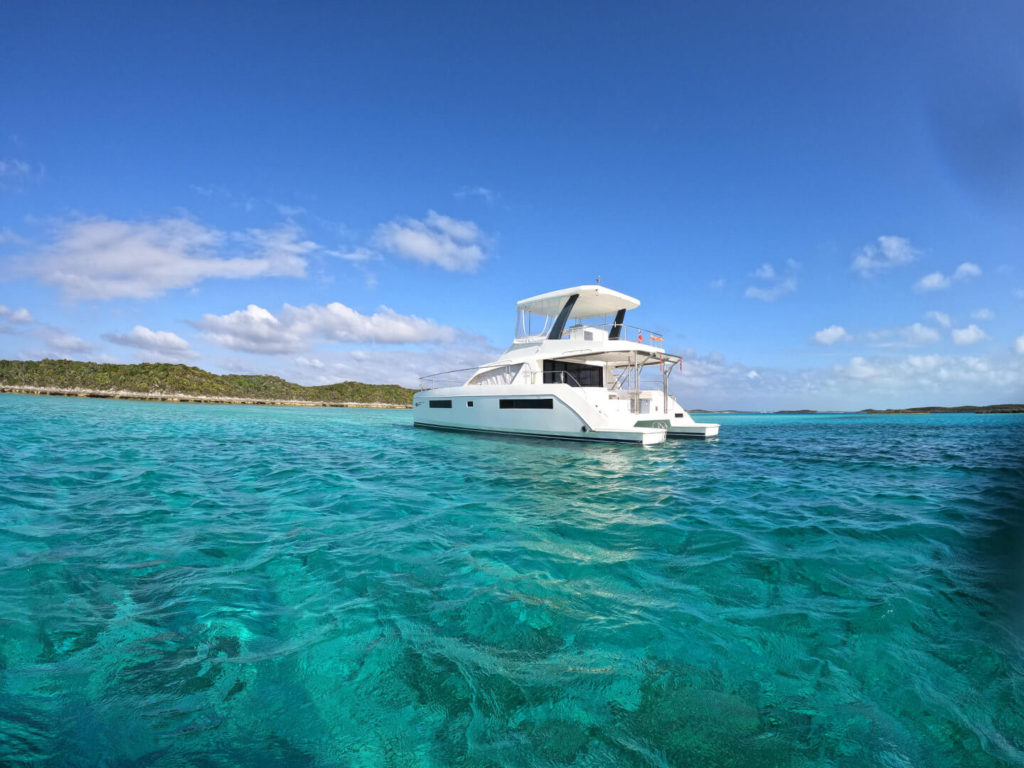
What advantages does a power catamaran have over a sailing catamaran? To find out, we bareboat chartered the Leopard 43 Powercat (aka 43 PC) from The Moorings in Nassau, Bahamas to cruise the Exuma Cays for a week. Let’s see how fast she goes, much fuel she burns, how much gear she can store, and how she handles in the marina and at sea.
- Twin engines make close quarters maneuvering a breeze
- Tons of storage and space to swing your arms
- Speed to support an aggressive itinerary
- Shallow draft for navigating shallow water
- Disappointing handling in heavy seas
- Thirsty on fuel when compared to sailboats
- Poorly looked after by The Moorings/Sunsail Base in Nassau
How Big is the Leopard 43 Powercat?
The Leopard 43 Powercat is the smallest power catamaran in the Leopard line. She blends the bones of the Leopard 40 sailing catamaran and the Leopard 51 Powercat. Between the waterline and the salon roof, the 43 PC seems almost identical to the Leopard 40 sailing catamaran, carrying her extra three feet in the swim platform…possibly to improve prop pitch and trim the yacht out while on a plane. However, like the Leopard 51, she has over 500 horsepower to get up on a plane and GO!
She also shares similar lines to a Leopard 51 with a hard-topped flybridge in lieu of a boom, mast, and cockpit helm. This easily doubles the outdoor deck space compared to the Leopard 40. She also trades a trampoline up front for a hard-decked bow. With a draft of 3’1″, the 43 PC is a full foot shallower than the 40-foot and 2″ shallower than the 51. This is also an improvement of three feet or more when compared to sailing monohulls in this size range. Heck that’s even a few inches less than the Nordic Tug 26 we tested last year. In the shallow waters of the Bahamas, this gave us a ton of confidence when venturing close to shore and through shallow passages.
How does the Leopard 43 Powercat compare to other types of yachts? Being a catamaran, the 43 PC is incredibly roomy compared to monohulls. I’m not aware of a monohulled powerboat under 50 feet with four very usable staterooms and two heads. While you might find those sleeping accommodations in some monhull sailboats under 50 feet, you won’t find them with the deck space and storage space that you’ll get on the 43 PC.
Even among catamarans, the 43 PC gives you a lot of yacht in 43 feet. Compared to the 38-foot Lagoon sailing catamaran we chartered in the British Virgin Islands , this yacht felt much larger in every part of the yacht. Leopards are designed for the charter market and prioritize space and comfort at anchor. On internet forums, yachts designed for bareboat charter like this one are derisively referred to as ‘condo cats’. I think it is an accurate metaphor, but I don’t take exception to it. Boats are a series of trade-offs, and this one ticks a lot of boxes for the Busy Boater crew that’s just looking for a week of low stress near shore cruising. We aren’t looking to make ocean crossings or deal with long-term ownership issues.
So, while the Leopard 43 Powercat is a small 43 footer by Leopard’s standards, it is about as much boat as you’ll find packed into 43 feet elsewhere.

At the Helm of the Leopard 43 Powercat

This power cat has one helm station. It is located on a flybridge that caps the salon and cockpit. Most of the flybridge is covered by a hardtop. It comes standard with vinyl windows on three sides to protect you from the weather. Without a lower helm, this feature is very handy. When you are cruising at 15 knots against a 20 knot headwind, that’s 35 knots of wind at your face. Add in some rain, and it ain’t a pleasant experience without at least this plastic sheet to shield you from the weather.
Luckily for us (/sarcasm), the yacht we chartered did not have its front vinyl panels. We asked to swap or pull some from another yacht, but were denied. This made running in a downpour on our first day out a downright miserable experience. We were surprised to also get sprayed all the way up here when cutting through some 4-foot seas in Exuma Sound. The windows can be rolled up out of the way on a nice day, or, like in our case, when an incomplete set gets ripped from its threads and you have to makeshift repair them at sea.
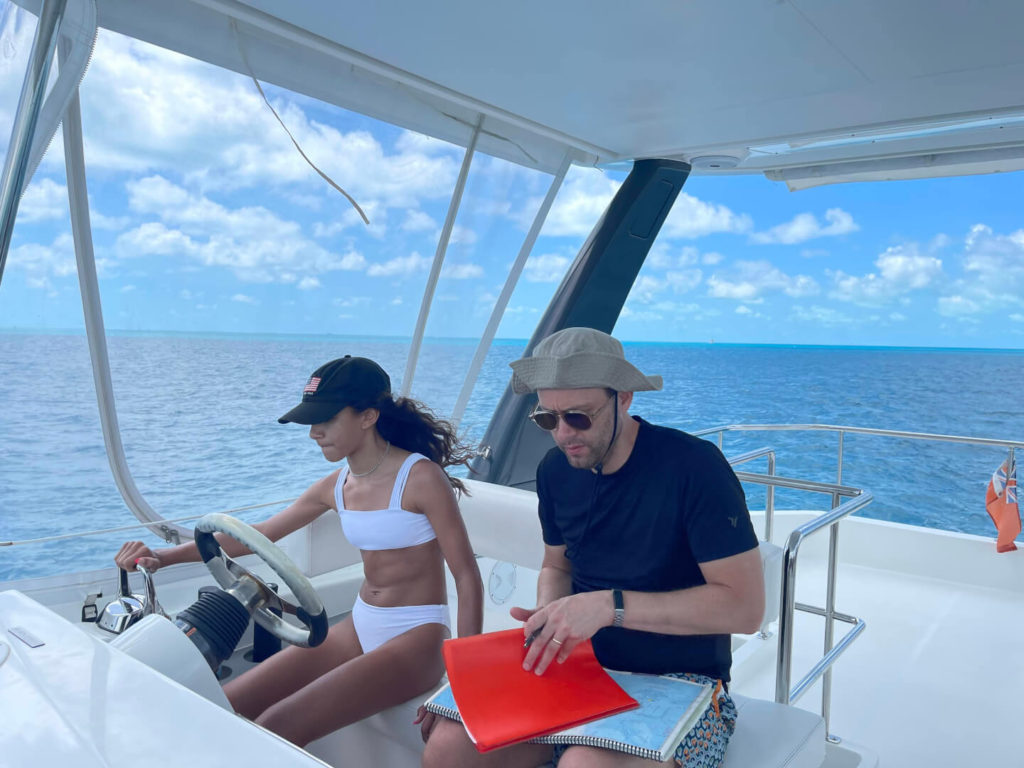
The helm seat is against the port (right) side of the flybridge. The seat is wide enough for two to sit comfortably with space in between. However, the small wheel is offset to the right and the throttles are set low and to the right of the bench. So, its hard to share the controls or take over when training a newbie. While the seat is very comfortable, the controls are mounted too low to stand at the helm, and there isn’t much to hold on to or lean on. Although, when getting drenched in a deluge one day, I set the autopilot and watched from the back of the flybridge at the stairway to get a bit further out of the rain.
The Yanmar engines come with electronic controls. The throttles can be synced to run at the same speed with a single handle when cruising. On twin engined powerboats you can sometimes find the engines out of phase just enough that they resonate with an annoying wah wah sound and vibration, but electronically synchronizing throttles eliminates that. The Yanmar engine display only showed the status of one engine at a time, and we were unable to figure out how to toggle between the two. You could watch RPMs on the Raymar multi function display, but I had to crane my neck to the left to see them while adjusting the throttles on the right.

Electronics

The Leopard 43 Powercat comes from the factory with a VHF mounted above the electrical panel in the salon with a remote VHF mic hung on the side of the helm. At the Moorings Nassau base, they remove these because they get damaged by the salt spray…like my hat, face, etc. No matter, our VHF didn’t work anyway. The yacht had a charging station for a handheld VHF, but that too was missing.
Our yacht had onboard wifi available from The Moorings for a fee. We spoke with returning charterers at the base who said it was no more effective than the wifi on their cell phones, so if you have a good international cellular plan or a Bahamian SIM card, this isn’t a worthwhile option. We did find that when cell signals were weak, we could turn set one phone up as a hotspot and leave it on the flybridge for better reception and connect to it with other phones in the cabins to improve performance.
The yacht has a Fusion stereo, controlled with the RA70 head unit at the electrical panel and MS-NRX300 remotes at the helm and the galley. This system is a very popular OEM choice for good reason. It is solid, simple, easy to use, and easy to read in harsh conditions. Plan to bring a few mixes downloaded to your phone to pair to the Bluetooth as access to radio stations and cellular internet may be spotty. There’s also no holes for CDs or tapes.
You can control everything from the remote units except balance levels across the four zones: bow, salon, cockpit, and flybridge. The zones could only be controlled from the head unit on the electrical panel. This wouldn’t be annoying except that if you have one zone turned all the way down at the head unit (to mute it), but turn the volume up from a remote, it brings each zone up proportionally and will turn on the muted zones. You can overcome this by controlling the volume on your phone. With a pair of 6.5″ marine speakers in each zone, you can crank it up plenty enough to annoy everyone in the anchorage, but you won’t be blowing any doors off. We had to tinker with the tone and volume settings to get a reasonable volume on the flybridge that overcame the engine and water noises without distorting while underway.
Raymar Electronics Suite
A suite of Raymarine electronics is included from the factory with two multifunction displays that can show tank status, engine status, chartplotter, fishfinder, and a camera pointed at the stern. It does not come equipped with a radar or AIS. The two displays are different sizes, but work identically and can toggle between the same screens. We used the larger screen for the chartplotter and the smaller to show the engine and fuel info while under way. The displays could also had a screen for levels of tanks and batteries, as well as an alarms screen that demanded attention with loud beeping until you toggle through and acknowledge.
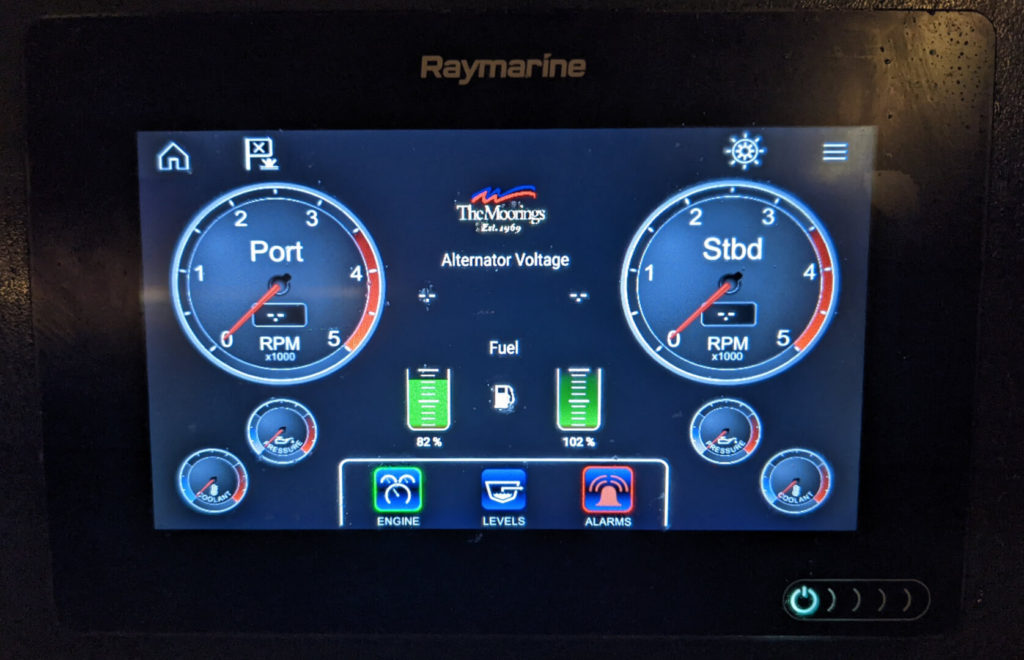
The multifunction displays are touch screen and work very effectively with two exceptions. One, the power button is a PITA, so we mostly left them on and covered in the evenings. Two, once sprayed with saltwater, the touch functionality is seriously impaired; this is not good when in rough seas trying to adjust the chart.
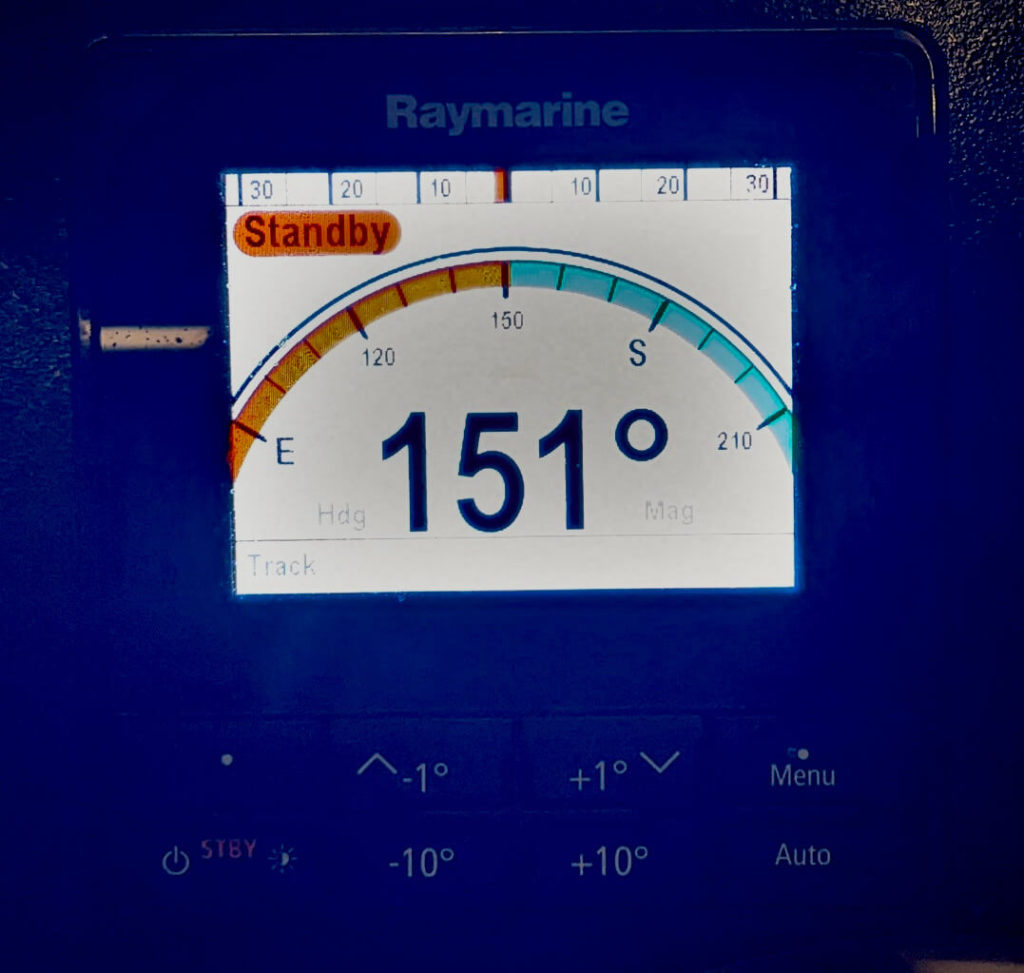
There’s also a separate screen to control the autopilot that includes rudder indicator (you know how I love rudder indicators!) and heading. There is no water speed indicator on this yacht, only speed over ground from the chartplotter.
According to Raymarine, the chartplotter module can be connected to the Navionics boating app on your phone to transfer waypoints and routes. We were unable to connect Navionics to send our waypoints. The checkout skipper didn’t know that was possible, but was eager to figure it out. The manual was not helpful (common theme), but we eventually found the menu and needed a password to connect to wifi, which we didn’t have.
Under Way in the Leopard 43 Powercat
The Leopard 43 Powercat has relatively small rudders, so the yacht is not very responsive to the wheel at slow speeds, and do not induce a pivoting turn like you’d expect on a yacht designed for slower speeds. What I mean to say is turning the yachtt with the wheel SUCKS. However, with twin engines placed a mile apart, it was a breeze to maneuver using the throttles. One engine in forward gear and one reverse easily spins the yacht within its own length. Running one engine at a higher speed than the other, or bumping one into neutral, are very effective at turning while running. Once over 5 knots or so, I relied almost exclusively on the autopilot, which again was easier than maneuvering the teeny little sport wheel. So I never really used the wheel, but the kids always insisted on using it when they took the helm.
There are no trim tabs to adjust the height of the bow while on a plane for comfort and efficiency. I don’t understand the physics, but this is apparently common in catamarans. The yacht did maintain a good trim at different speeds and sea states, regardless.
We found ourselves almost exclusively on the flybridge when underway. When running on a plane, the yacht has enough bounce that its a bit unnerving to climb down the stairs and be anywhere near the stern. Unlike most motoryachts, the stern is open on the sides, and our yacht was missing a lifeline down the center. You also get more engine noise in the salon, and when in rough seas, you get some nasty hull slap that isn’t really noticeable on the flybridge, but throws the floor and table with quite a crash down below.
How Does the Leopard 43 Powercat Handle Rough Seas?
When I describe rough seas, everything is relative. For most of our weeklong charter on this yacht we were on the Exuma Bank, protected from rough seas by the Exuma Cays. When crossing the yellow bank from Nassau, where the sea is a bit more exposed, we got some 1-2 foot seas, which the yacht smoothed right out when on a plane.
One day we crossed a cut between the island chain out into the Exuma Sound to save some time. Well, honestly, we also did it to say we’d crossed a cut and spent time in the Sound…and to give you the yacht test you deserve. The cuts, which are thin channels between the islands, can be challenging because the tides create a lot of current as water is exchanged from one side of the islands to the other. When the current is against the wind coming in from the Sound on the east side of the islands, the surface water in the cuts can also be very violent. However, with 640 horsepower at the stern and good timing, the cuts themselves were no match for us.
Surprisingly though, once out in the Sound, we found some very confused seas. The waves were only four feet, but very close together, maybe a second or less apart. They were mostly (but not all) coming from the East, so we’d have them at our bow on the way out, beam on the way north, and stern as we crossed back into the Exuma Bank.
Taking the waves head on, I was deftly afraid of stuffing the bow and learning more than I ever wanted to about nets vs solid catamaran bows. Then, when we had the waves at our side on the beam, the yacht rocked too and fro with such velocity that my stomach would get roller coaster like butterflies…sitting up high and exposed in the flybridge, this was downright scary.
We found the smoothest ride ‘quartering’ the seas with the waves 45 degrees off the bow with the hammer down going over the waves as quickly as possible. However, we still got pounded something fierce. The bow of the pontoon on the side taking the wave would occasionally plow under it and throw buckets of water up to and across the flybridge, drenching the entire crew.
Perhaps more unsettling was that there’s not much in the way of good handholds when sitting on the U-shaped settee (couch), or on the inboard side of the helm seat. Meanwhile, down below in the salon, the kids thought this roller coaster ride was a blast, jumping with the hull slaps…until one blew ramen chunks in the sink…then the microwave broke loose and fell in the dish drainer, and they realized things were a bit serious and took their seats…using a foot to keep the broken refrigerator drawer from swinging in and out.

Finally, with a rising tide, we had wind waves and current at our stern when we headed back through a cut North of Warderick Wells. Well prepared to ride the surf like a boss after doing it in Maui , we cautiously turned toward the cut. Unlike the nimble 24-foot catamaran we had there, this yacht could not go as fast as the surf to maintain control. Even with the hammer down, the waves would crash at our bow, pushing us well over 20 knots! I was able to maintain control by throwing the engines in reverse to get behind the waves as they caught us. We didn’t need to turn until we got out of the surf, but if we had, I’m certain we could have turned out with the throttles, but I’d be wary of counting on our tiny rudders to be much help.
Our yacht was equipped with twin Yanmar diesel V8s with 320 horsepower. These are optional engines. The base engines are 260 horsepower straight sixes; also Yanmar Diesel. Access to fluids was relatively easy, with the dipstick, oil filter, coolant, impeller, sea strainer, and fuel filter all located towards the front of the engine. The sea strainer was located above the water line, allowing it to be cleaned without closing the through hull: if you open a sea strainer below the water line with an open through hull, sea water will rush into the yacht making a mess and causing panic…if you close the through hull to work on the strainer, but then forget to open it when done, you’ll overheat the engine. So this is a simple improvement to help overcome some of our stupidity.
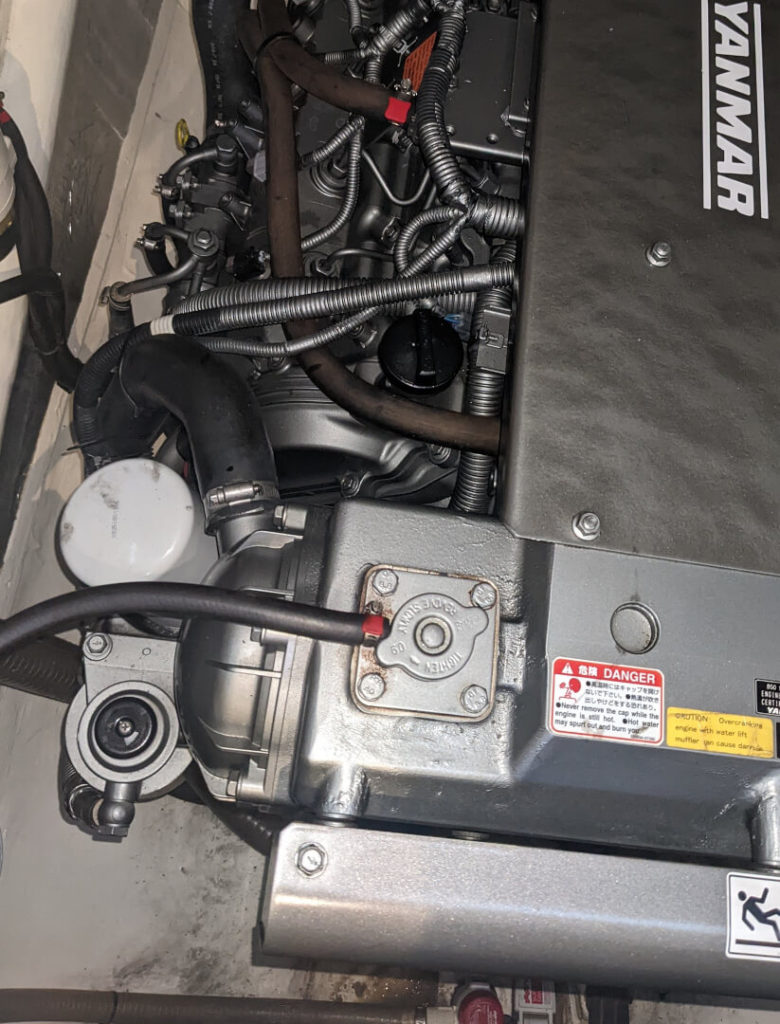
How Fast and Fuel Efficient is the Leopard 43 Powercat?
Without a water speed indicator, or a GPH indicator (that we could find on the MFD), we were unable to precisely measure the engines’ performance. In charter service the engine’s throttles are limited by a piece of plastic screwed into the side of the throttle controls. With the limiter in place, we were able to get the engines up to 3,000 RPMs and cruise around 17 knots (20 mph) in calm seas. This was about a knot slower than specs we read on the internet, which might be credited to the very dirty hull we got. Expect to lose about 2 knots off the top end with the standard 260 horsepower straight-six engines.
What is the Benefit of the Powerboat Speed?
While most of our hours were running with the hammer down at 3,000 RPMs, we also found a comfortable cruise at 2,000 RPMs where we made 9-10 knots and 1,500 RPMs where we made about 7 knots. A 17-knot cruise is 10 knots or 140% faster than we’d expect to motor on a similar length sailboat.
This speed allowed us to run 78 nautical miles from Nassau to the Southern end of our cruising grounds at Big Major Cay in just over 4.5 hours. With our 1:00pm departure, we would not have been able to make that run by sundown on our first day. On our last day we were able to slow down a bit and still run the 37 nautical miles from Highbourne Cay back to Nassau in 2.5 hours. With the yacht due back to Moorings/Sunsail in Nassau by 10am, this would again not be possible in a sailboat.
So, when chartering in a big cruising ground like the Exumas, the powerboat speed buys you, at a minimum, one extra night in the out islands as you really need to head back to the marina the night before a 10am turn-in with the sailboat.

How Much Fuel Does the Leopard 43 Consume at Speed?
On our weeklong trip we burned 185 gallons of fuel with 13 hours on the generator and 18 hours on the engines. Northern Lights states that the 9kw genset burns 0.5-1 gallon per hour (so we’ll assume 13 gallons for the generator). We ran the engines for 11 hours at 3,000 RPMs, 1 hour at 2,000 RPMs, and 4 hours at 1,500 RPMs. We ran mostly at 3,000 RPMs before our first refueling, so I can estimate that we burned about 16 gallons per hour with the hammer down at the 17-knot cruise. That’s actually about 2 gallons per hour better than the internet told us to expect.
With 264 gallons of tankage, we could have gone the full week without refueling, but we did refuel after our big run south on the first day (90 gallons). At sea, it isn’t wise to plan to burn more than half of your fuel, especially when you aren’t familiar with the boat. On a similarly sized monohull, we might would have run 34 hours to make the same distance, but closer to 1 gallon per hour. So, fuel burn would have been less than 50 gallons under comparable use on the monohull, or much less if we sailed and used less generator. However, running a speed in the mid-teens at about one gallon per mile like we did is very comparable to a similarly sized pilothouse monohull motoryacht.
The engines are mounted under the beds in each of the stern staterooms. Many sailing catamarans have the engines mounted further aft (towards the stern). Often in these cases, a sail drive is used to allow the prop to mount at a perfect 90 degrees to the hull. However, sail drives are not rated for the kind of horsepower this cat carries. So, like most motoryachts, the Moorings 43 power cat uses a driveshaft that puts the prop at an angle. The more angle on the prop, the less efficient it will work. So mounting the engines as far forward as possible reduces this angle. With regular access needed below the bed, the platform is raised and lowered on a motorized switch.
I was surprised at how quiet the engines were under way. While, they were nowhere near as quiet as our Nordic Tug 26 , they were tolerable even when in the laying in the bed. directly above the engine. Sitting on the flybridge, you are far enough away from the engines that the noise isn’t bothersome at all.
Leopard 43 Powercat Galley
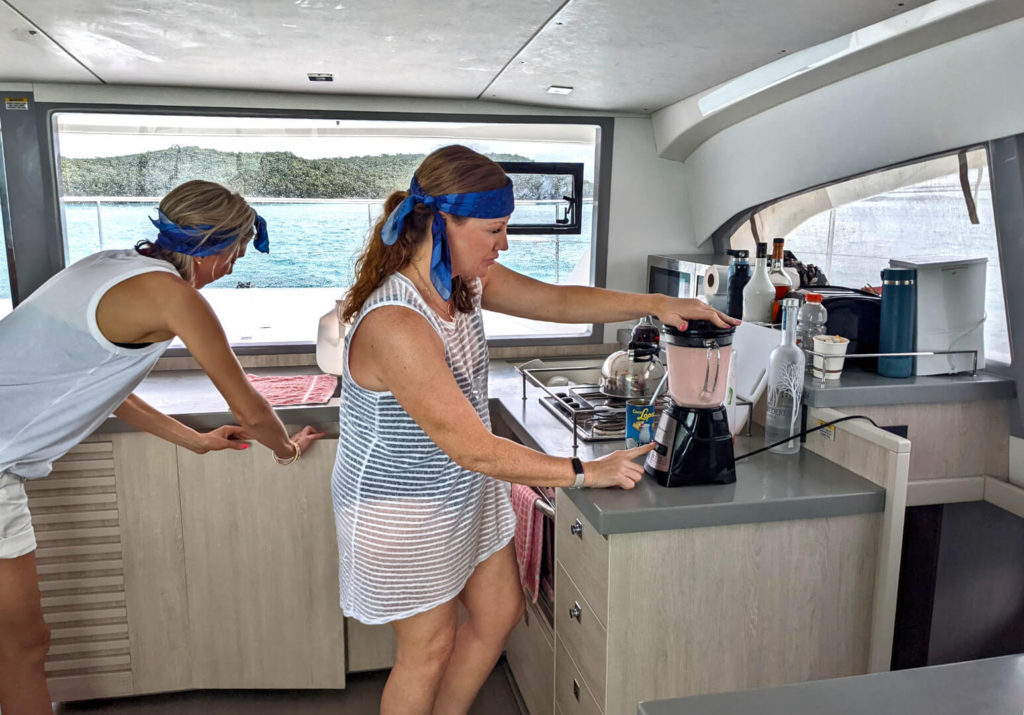
The galley in the Leopard 43 Powercat spans the port and forward edges of the salon. There’s a lot of counterspace with the dish drain recessed with a cover when not in use. The design also takes advantage of space that had to be elevated for headroom down below by elevating the rear of the counter for appliances and storage.
Galley Storage
There’s lots of storage with generous bins for in the salon floor. These work great for bagged dry items like cereal and rice if you remove the box before departing (also reducing trash to hold later)…just be sure not to step in them while open or not properly set or you’ll have little bits of ramen to clean without a vacum or broom/dustpan. There’s also a small cabinet in the stairwell for dry food storage. A very deep cabinet next to the sink holds a generous amount of cups, bowls, plates and storage bins for leftovers. A set of drawers next to the oven holds the utensils.
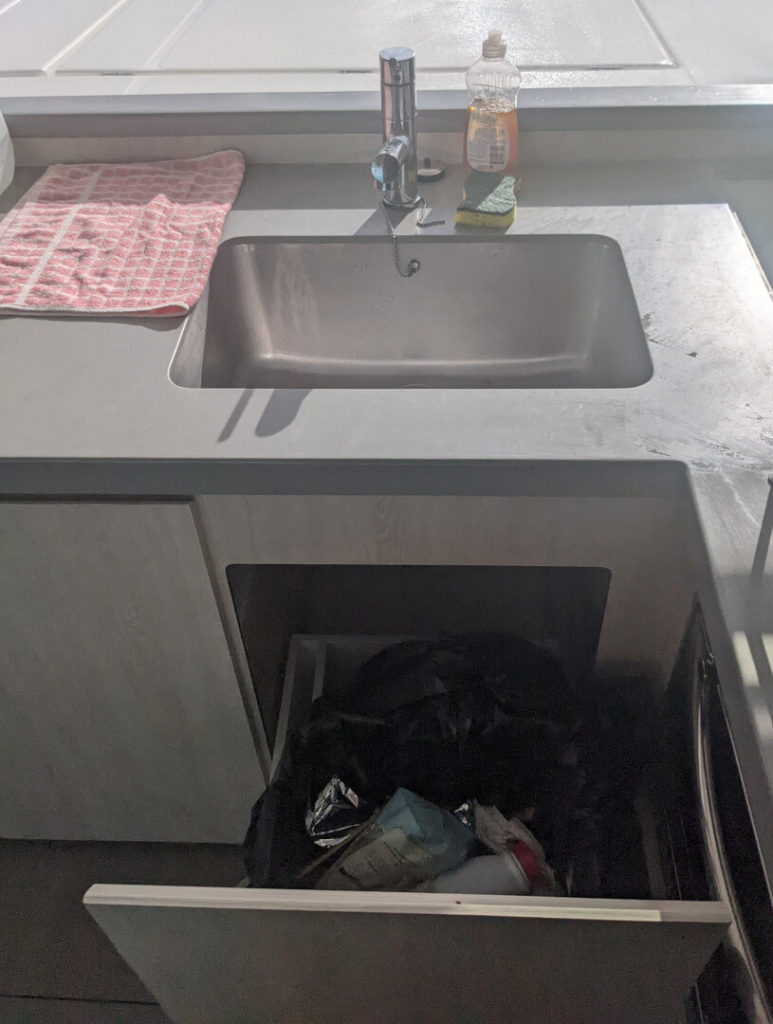
There was a trash drawer below the sink that hung two bins to allow for sorting.
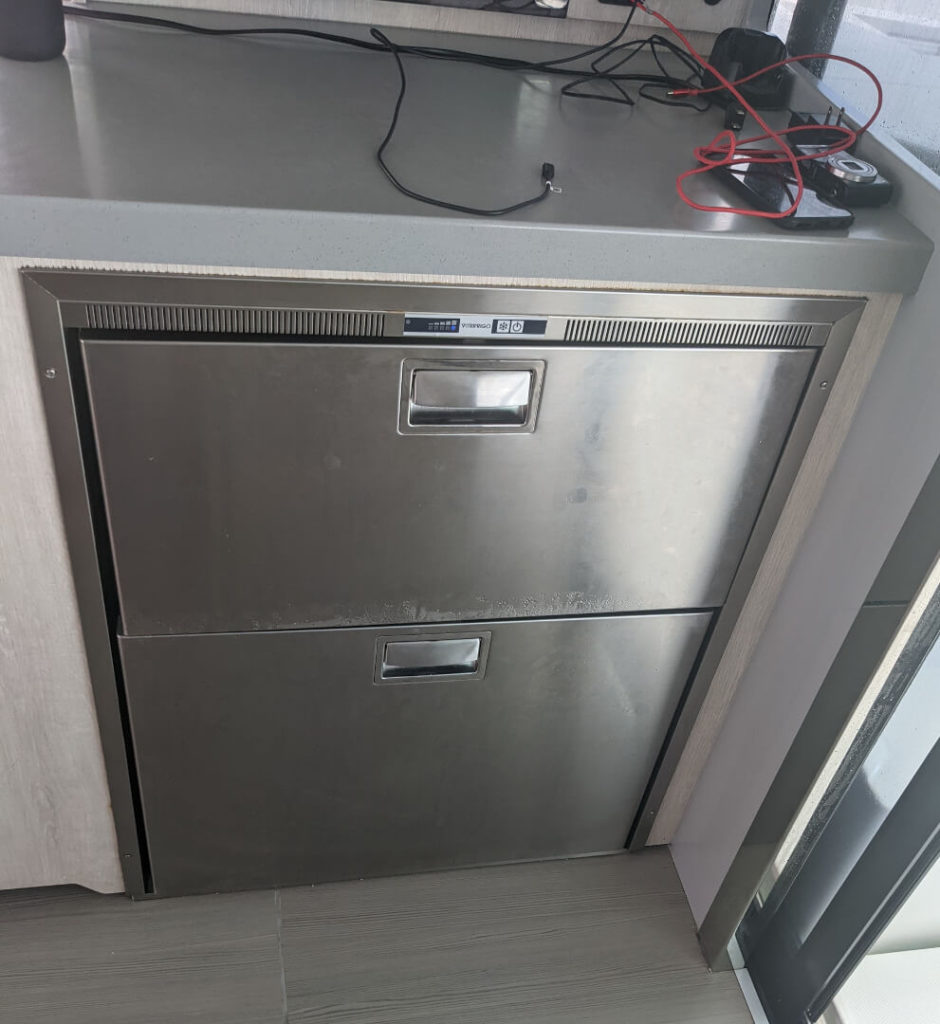
The combination refrigerator/freezer is away from the kitchen at the companionway door below the electrical panel. It utilizes two drawers to facilitate easy access down low. Our drawers were helplessy misaligned in their tracks, so the refer wouldn’t latch and would slide open and closed in rough seas, while the freezer had to be lifted and pulled open from beneath because it was too tight to get enough purchase with the handle.
The freezer was very effective at keeping things frozen. There was room for two 10 pound bags of ice in here plus more. It is cold enough to make larger blocks of ice to keep a cooler cold during your trip if needed. The bottom drawer is a fridge, while the top is a freezer. The fridge drawer was slightly larger with a shallower shelf in the rear 2/3 to make room for the compressor beneath. There is only one temperature control for both drawers. We had no trouble holding ice in the freezer all week without freezing anything in the fridge.
Galley Appliances

The 3-burner range operates on propane. The electronic ignition on the burners did not work, but The Moorings includes a grill lighter with utensils knowing they can be finicky. The stove was adequate, if a bit crowded, for preparing meals. The oven was relatively small, but included one glass and one aluminum pan that were designed to span the full width of the oven, allowing you to make the best of it…which was fine for anything other than a turkey or crown roast. Our checkout skipper was surprised that the electronic ignition worked on the oven, so plan on lighting that with the lighter too. We were unable to get the broiler to work, and the user manual only had info on installation, not operation. This wouldn’t have been frustrating if our flybridge BBQ was operational.
The range was equipped with an electric propane valve and propane sniffer. Our valve sounded the propane alarm during our sea trial. After finnicking with it for a bit and throwing the breaker, it stopped complaining, but the valve never closed, allowing propane to the stove regardless of setting. Our checkout skipper told us it was fine. While it wasn’t ideal, we closed the tank valves when not using the range and didn’t get blowed up.
Electric Appliances
Our test yacht was equipped with a microwave, blender, four slice toaster and coffee maker that all ran on 120v electricity. With no stovetop percolator or French press, that meant that you needed to start the generator to make morning coffee: put the first couple to rise in the starboard stern stateroom to minimize the impact. You could also consider bringing a pour over funnel or aeropress to reduce generator usage.
Another issue with the appliances is there are two 120v appliance circuits with one serving each side of the yacht. This meant that while there were three sets of outlets in the galley, they were all on the same circuit and could only power one appliance at once (without tripping breakers). So, we had to run the coffee pot from the chart table (which was on a separate circuit) in order to make toast and coffee at the same time. Finally, I will note that we started out with a fully functioning four slice toaster that failed on one side a few days into our trip and then eventually the other side failed, leaving us with floppy bread for the rest of the voyage.
The sink is served exclusively by the electric fresh-water pump. There’s no foot pump for sea water pre-rinsing, or as a freshwater backup to the electric pump.
Auxillary galley: flybridge grill station

All Leopard 43 Powercats come with an electric grill and sink behind the flybridge settee. Some, like ours, also have an additional refrigerator up here. The extra cold storage is theoretically handy for a long voyage with a large group, or just to keep beverage traffic out of the main fridge. Unfortunately, our refer control was broken and would not get below about 60 degrees, so we just used it for beverage storage. I also can’t tell you how the grill worked because ours had an electrical short that popped the GFCI breaker immediately when turning on. This would have been a great place to cook most meals while without heating or stinking up the galley/salon.

Leopard 43 Powercat Flybridge
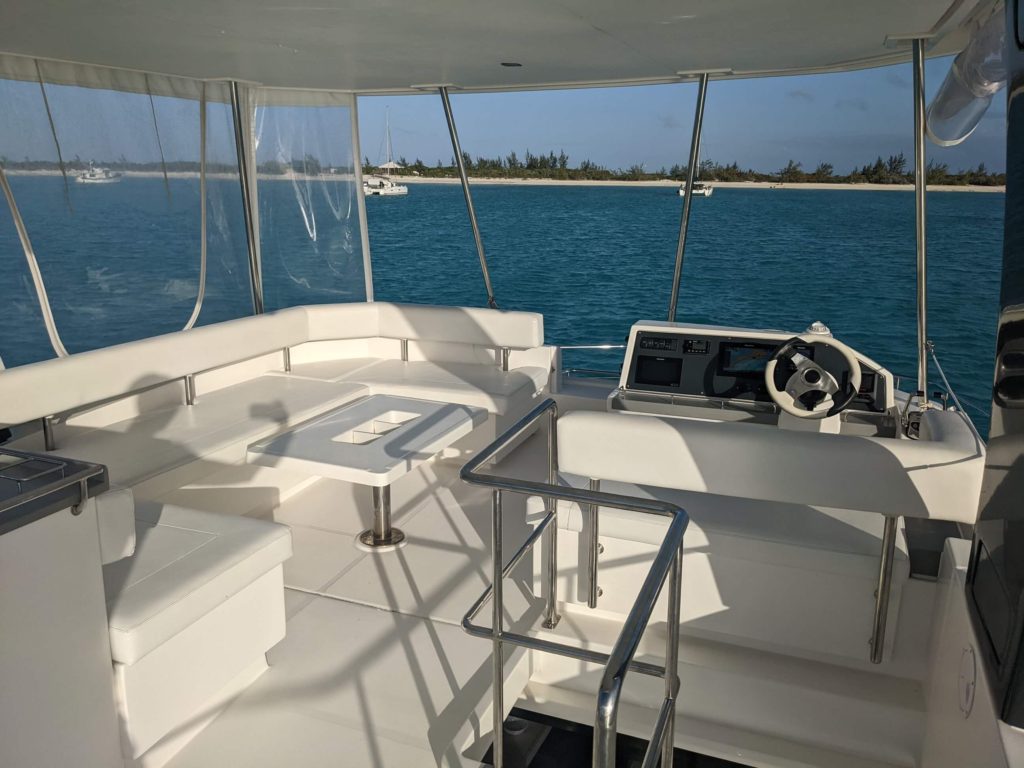
A big advantage of a powerboat over a sailboat, at least in this size class, is that the lack of a mast and boom allows for a large flybridge above the cockpit and the salon. When under way, the crew can sit with the wheelperson and enjoy an unobstructed 360-degree view. Our crew parked here almost exclusively while motoring. There’s lots of room up here to move around, sit, and lay down. A large table inside the u-shaped settee (couch) has three molded bins that are great for keeping phones, snacks, and water bottles from flying around while at sea.
A few downsides to note on this flybridge. There are only two cupholders up here, and they are located outboard of the helm seat, inaccessible to passengers. They also have an opening in the bottom that allows cell phones to slide out and fall on the floor. Perhaps more annoying: there isn’t much to hold onto when sitting at the settee. This can be very unnerving when getting tossed around in rough seas.
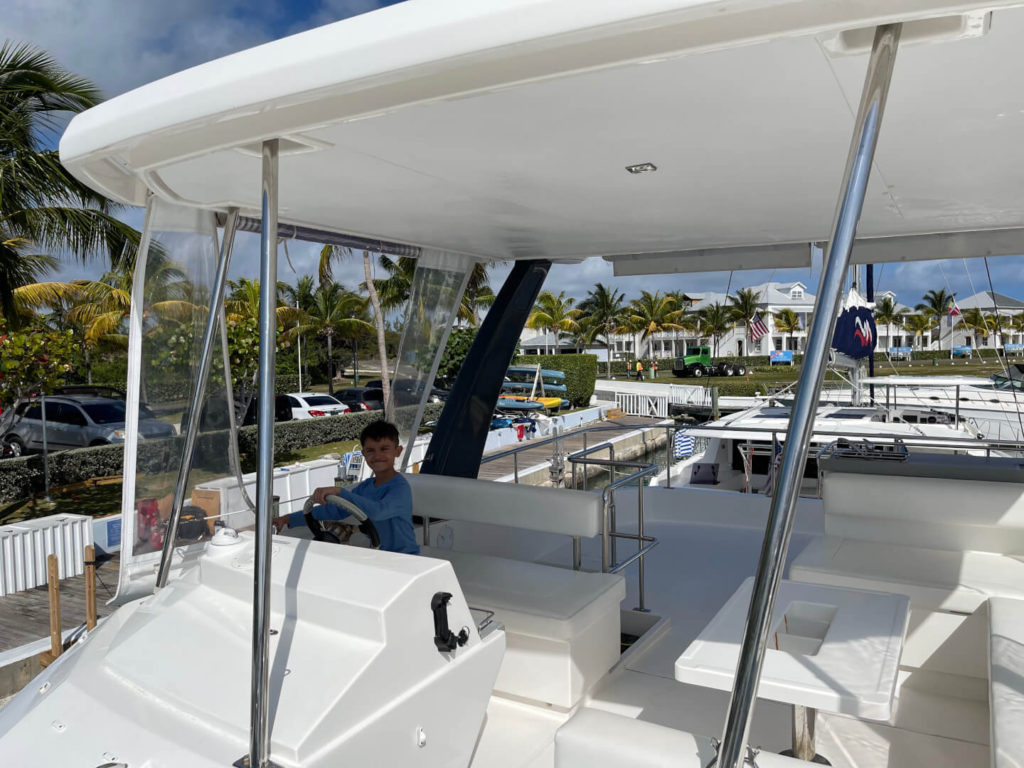
Ahead of the helm and settee, there is a passthrough to a sundeck that can be used while at anchor or under way in calm seas. In the absence of a trampoline on this cat, this ended up being our crew’s favorite spot to relax in the sun. There’s a back cushion, but no bottom cushion.
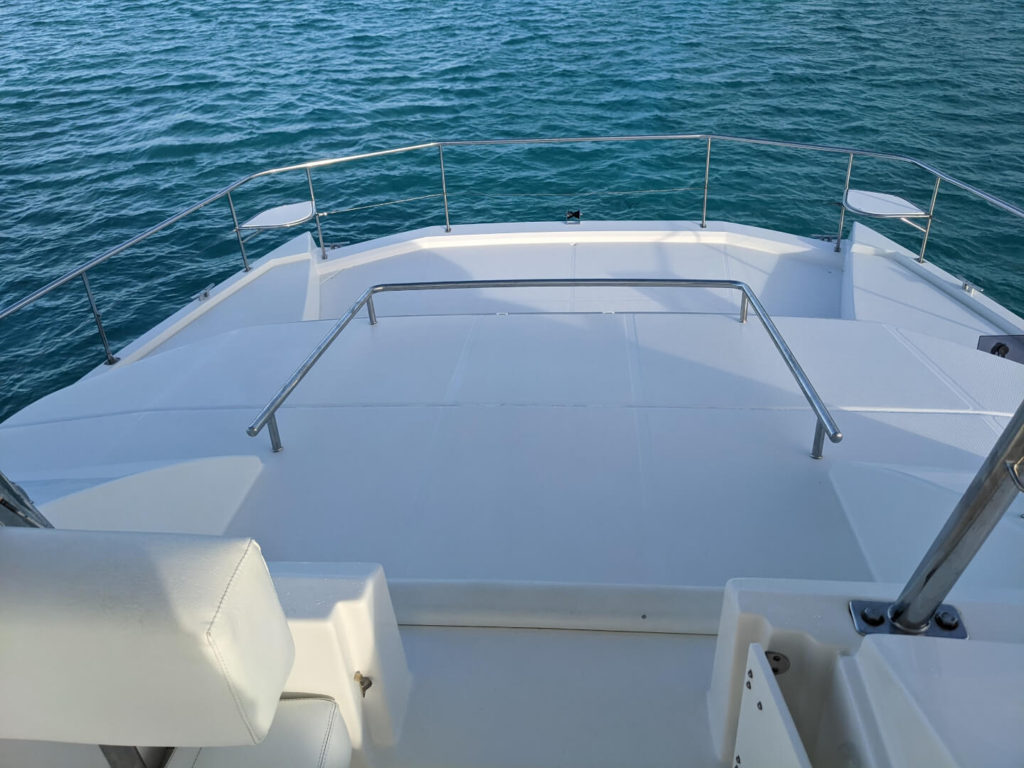
The settee cushions can all be lifted out to reveal an absolutely incredible amount of storage space. The gallon water jugs in the photos give some perspective as to the space. You could pack this with 60-70 gallons of water with space above the jugs for more. Similar storage is available below the helm seat, which we used to keep our charts, hats, and binoculars neat and dry…without the flybridge curtains, everything wanted to blow away.

Leopard 43 Powercat Bow Area

Many newer catamarans, especially power cats have eliminated the trampoline in favor of a full-length deck. The Leopard 43 Powercat follows this trend. There’s a lot of internet pontification about the dangers of stuffing the deck vs the benefits of riding the top of a wave. There’s also concerns about hull slap, which occurs when the wide deck between the catamaran pontoons gets banged by a wave. When we were in rough seas we got some very loud, crashing hull slap, but it was further aft under the salon where the trampoline wouldn’t have made a difference. We never stuffed the bow, so I can’t speak much to that, although in rough seas the fear or that giant deck going under a wave was very real.
We honestly didn’t spend much time on the bow or think much about it. However, I can’t help but think the kids would have loved laying on the trampoline and getting splashed like we did on our Lagoon 380 in the BVI .
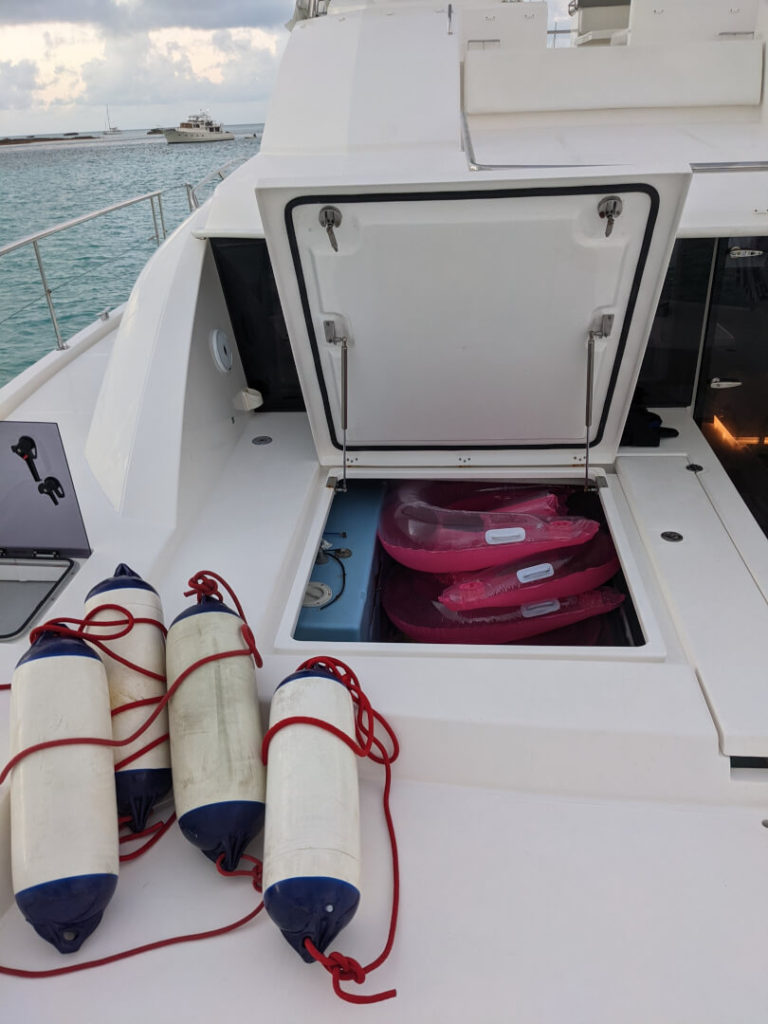
There was a HUGE storage locker in the deck that held the spare anchor, fenders, dock lines, and snorkel vests. This was a great place to throw wet toys and clothes while underway. We were able to store four large fully inflated floaties along with the secondary anchor and road, and four 8″ fenders with plenty of room for more. One of the two water tanks is located here; its translucent sides made it easy to confirm how much water remained. The other tank is is in a smaller locker on the opposite side of the steps.
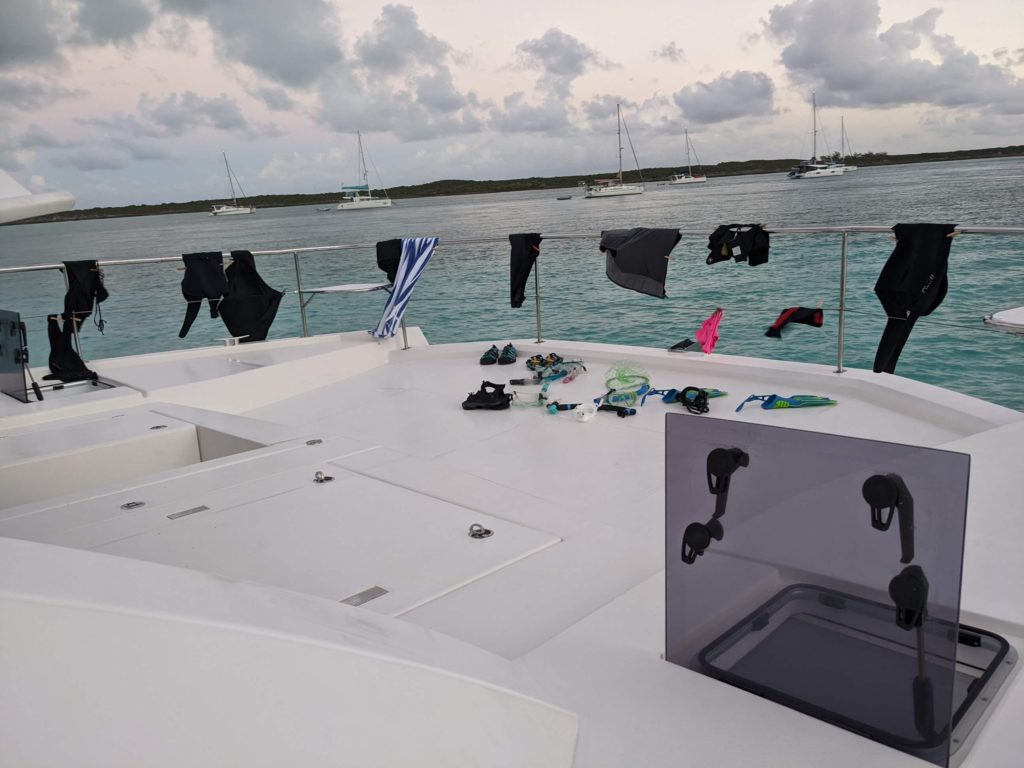
Leopard 43 Powercat Cockpit

The cockpit (rear seating area) on the Leopard 43 Powercat cockpit has yet another roomy U-shaped settee (couch) and dining table. This setting accommodates a larger crowd than the salon. The settee has fitted bottom cushions, but fiberglass backs. It is a bit easier to slide in and out of a crowded table because you can climb out onto the deck from the rear of the bench. The rearmost bench has a movable seatback that can be reversed; this allows your mates to sit facing the stern while at anchored.
The forward part of the bench can be lifted to reveal a large storage, along with the batteries. The rear bench holds the life raft and shorepower equipment on one side and a drained storage locker on the other. Our yacht had dinghy pump and inflatable life jackets stowed in the drained locker. This seemed logical, but the inflate handles on the jackets can get stuck in the large drain holes. When pulling the jackets out, one of them blew with my head in the locker…very startling!
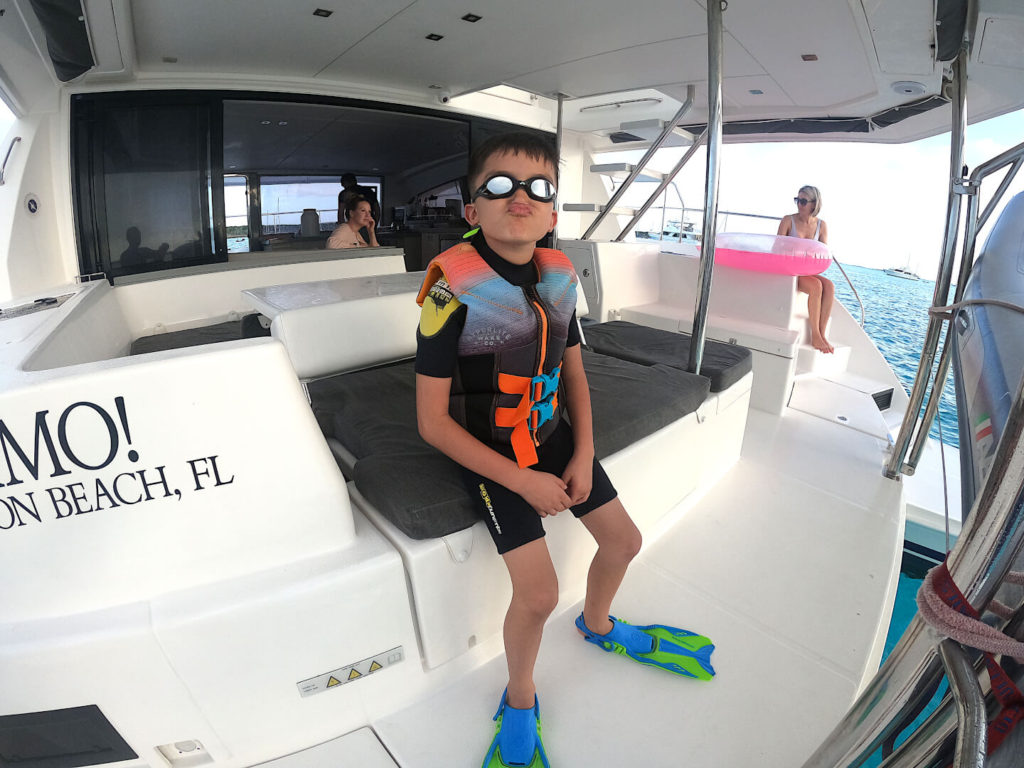
Another locker next to the life raft was used to store life jackets on our yacht; this locker has drains which is nice for this sort of thing, but the drains are large enough that one of the inflation handles got stuck and scared the shit out of me when I pulled it out and caused it to inflate with my head in the locker. Fortunately, there were a dozen or so rearming kits under the salon bench, so I was able to re-arm this one along with a few other vests that he been pre-inflated prior to us taking delivery of the yacht.
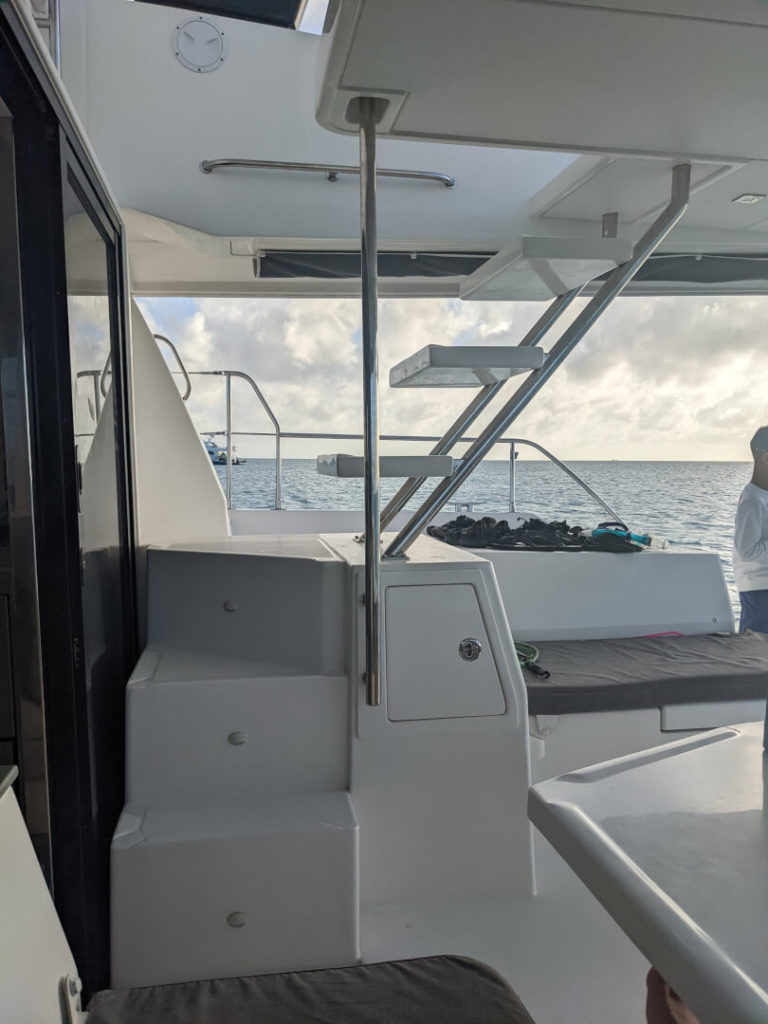
Opposite the settee you’ll find stairs leading to the flybridge. Under the stairs is a small bench that stores two propane tanks beneath.
The dinghy hangs from a davit between the hulls at the stern. An electric cable windlass is used to raise and lower it. In rough seas it can really get to swinging, so we used the dinghy painter (rope on the bow) to tie it more securely against the davit hardware. This is the most convenient dinghy stowage system that I’ve ever used.
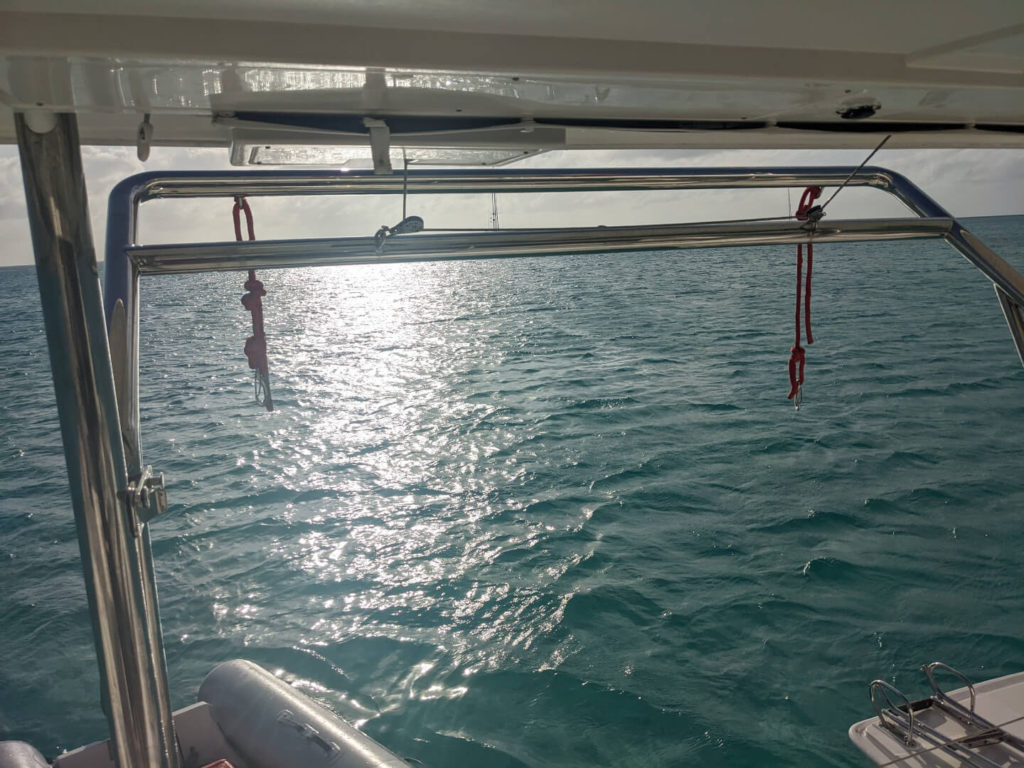
Stairs on either side of the stern lead down to a 3′ swim platform that makes up the Leopard 43 Powercat three feet longer than the Leopard 40 sailing cat. The swim platforms are welcome as they make it easier to board the dinghy. They also contribute to a straighter prop shaft that we discussed earlier, and likely help maintain a natural trim when running at higher speeds.

Half-way up the outboard side of the steps on either side is the diesel fill. These are positioned directly above the tanks so they are less likely to get backed up and barf petrochemicals all over your yacht and the sea. Nonetheless, its always helpful to have an idea of how much fuel you need and watch the meter so you can slow down when you think you are getting close. Our yacht did not come with oil absorbing diapers, which are nice to hold around the nozzle in case there’s a spill.
Below the steps on each stern, there was a ‘lazarette’ with even more huge storage areas. The starboard (right) side was wide open, while the hot water heater and generator were mounted in the port (left side).
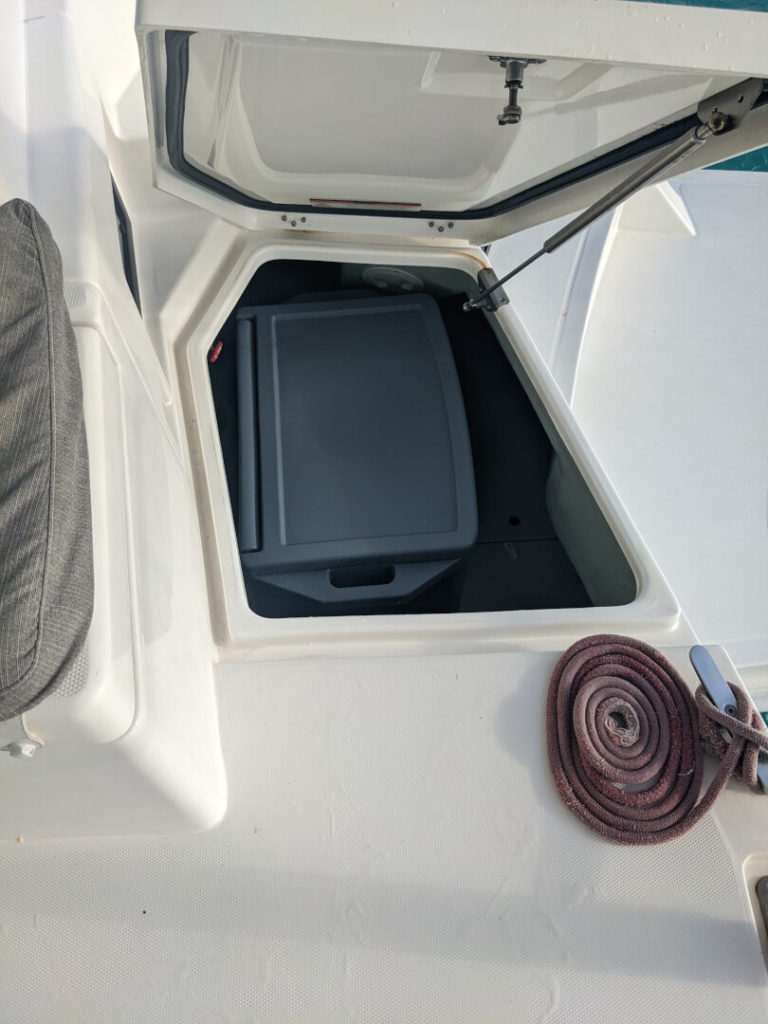
Leopard 43 Powercat Side Decks
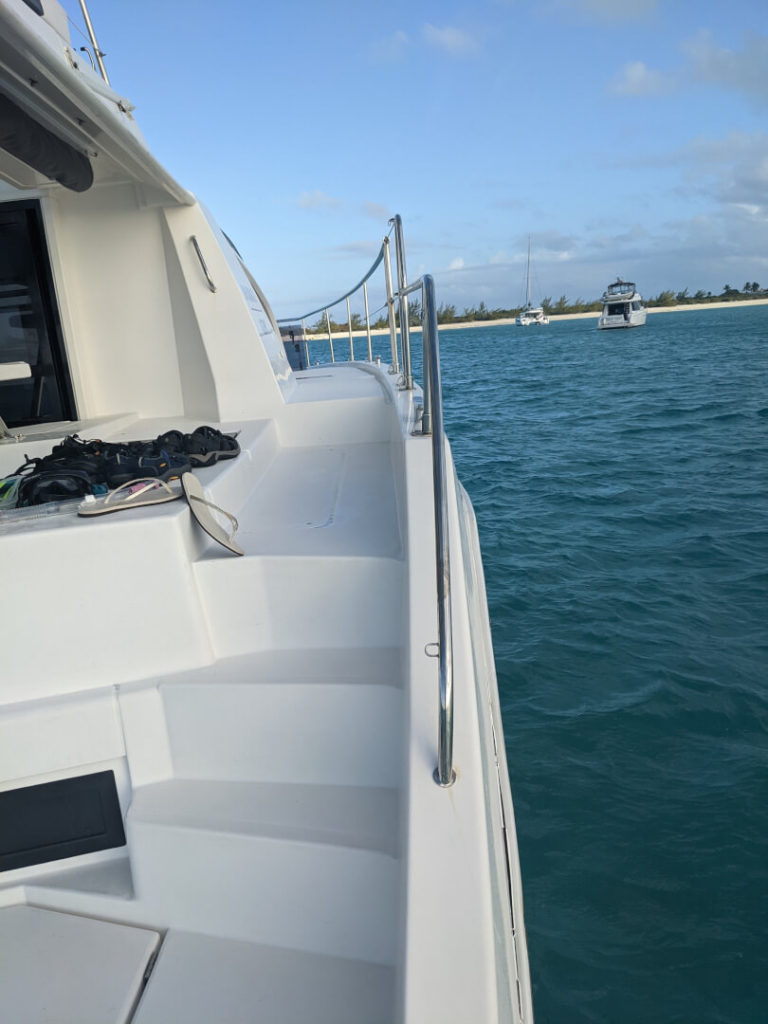
You will never fret getting from the stern to bow on the Leopard 43 Powercat. In addition to being able to walk through the salon, there are generous side decks wide enough to accommodate an above average American without shimying sideways. The decks are flat with solid full inch thick, tall stainless railings. This is a huge improvement over the tight, tilted gunwales protected by loose, low, frayed wire lifelines often found on sailing monohulls. We also found three very large and sturdy cleats along each side of the yacht capable of holding plenty of line for the most hamfisted of attempts to secure this thing to a dock.

The yacht comes equipped with mesh shades over the side windows that can be rolled up. We snapped them down before leaving port knowing that they would help keep the yacht cool. The snaps are these finicky little plastic things that require patience and world class dexterity to install. The same snaps also secured the cockpit cushions. If you needed justification to bring kids along on your voyage, this is it.
Salon on the Leopard 43 Powercat

Older cruising catamarans, and many performance-oriented catamarans, have a sloped salon roof making for a marginally useful area forward. However, the Leopard 43 Powercat has a full height salon with vertical windows forward and a door to access the bow. The door is a great way to allow open up a cross breeze while at anchor or on a buoy since you’ll have wind coming off the bow. Careful heading for the bow too quickly though, Abby the Giraffe bonked her head on the flybridge floor on her way up the steps…right in front of the checkout skipper, causing a commotion that certainly gave him pause. The door has a tight seal with three locks; there are two detents, allowing the door to be cracked for ventilation. Be sure to double check this is closed all the way before getting under way if you prefer your cabin dry.
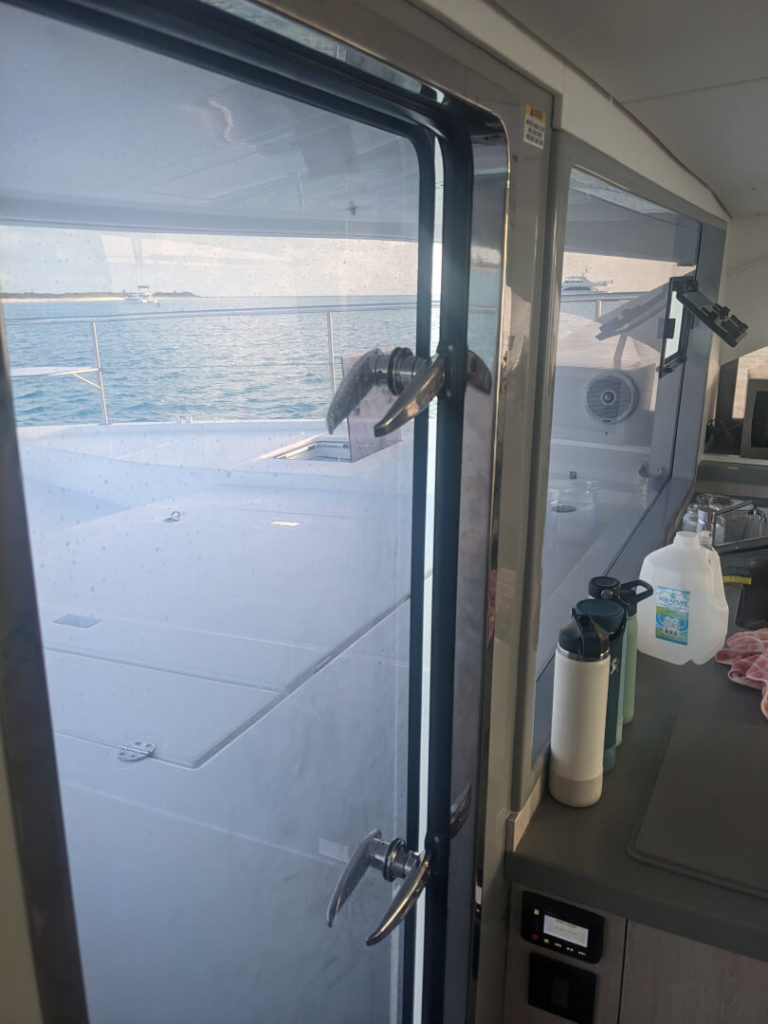
The salon has an L-shaped settee with a table that can be lowered to convert into a generously sized bed. Our 12 year-old slept here comfortably all week without ever executing the conversion. Getting in and out of the bench during dinner service can be a hassle. There are also two stools with storage underneath that can be set on the open side of the table to increase capacity or minimize in/out climbing. The windows between the salon and the cockpit slide open without any framing between that and the companionway door. This offers connection for crew sitting on either side, or just letting in a breeze.
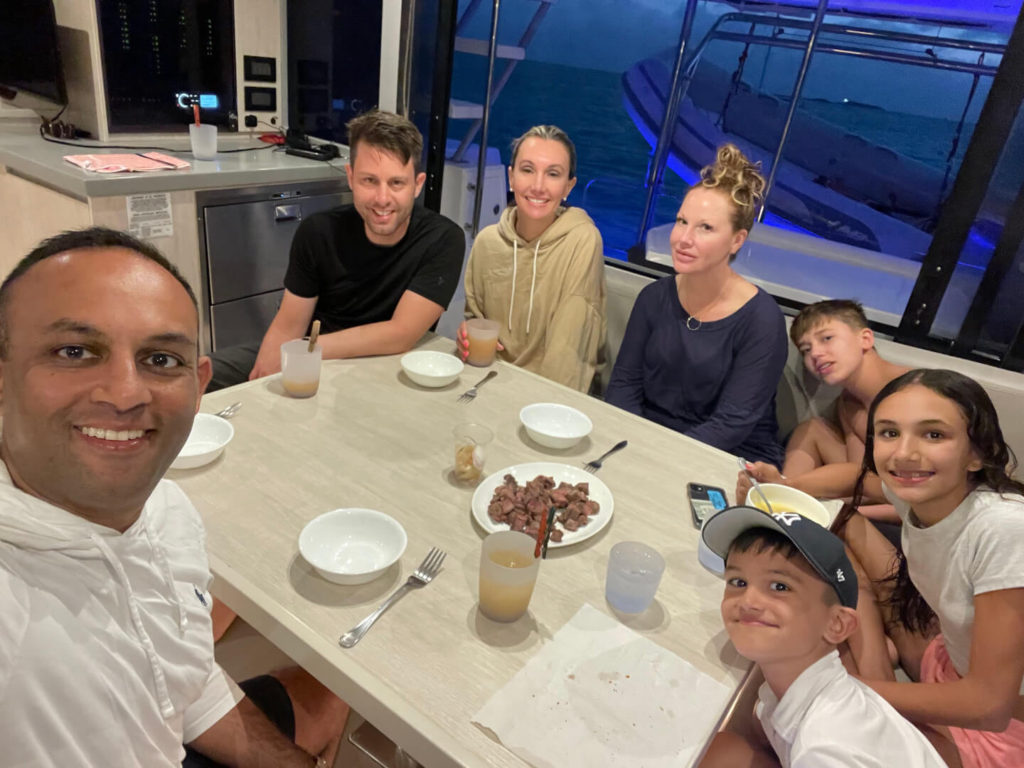
Across from the settee, next to the companionway door is the electrical panel. Behind the glass door, in addition to the circuit breakers is the controls for the air conditioner, watermaker (if equipped), VHF, generator, and stereo. Remote stereo controls are also mounted on the flybridge and next to the forward salon door so you don’t have to dive in there to tinker…although you’ll probably use blueteeth to run tunes from your phone and only need to access the volume settings after the initial paring, which was easy…don’t forget to download a solid playlist before leaving home in case you have limited internet access on your voyage.

In the final corner of the salon area, forward/starboard, there’s a navigation table with storage below. There’s also a deep long ledge over the living space below that’s great for holding random crap like binoculars, eyeglasses, and water bottles and for charging phones and cameras. There is a set USB and 120v outlets here as well as next to the electrical panel. The USB outlets work without the genset, the 120v do not as the yacht is not equipped with an inverter. With the helm on the flybridge, it isn’t easy to go back and forth to check charts while under way.
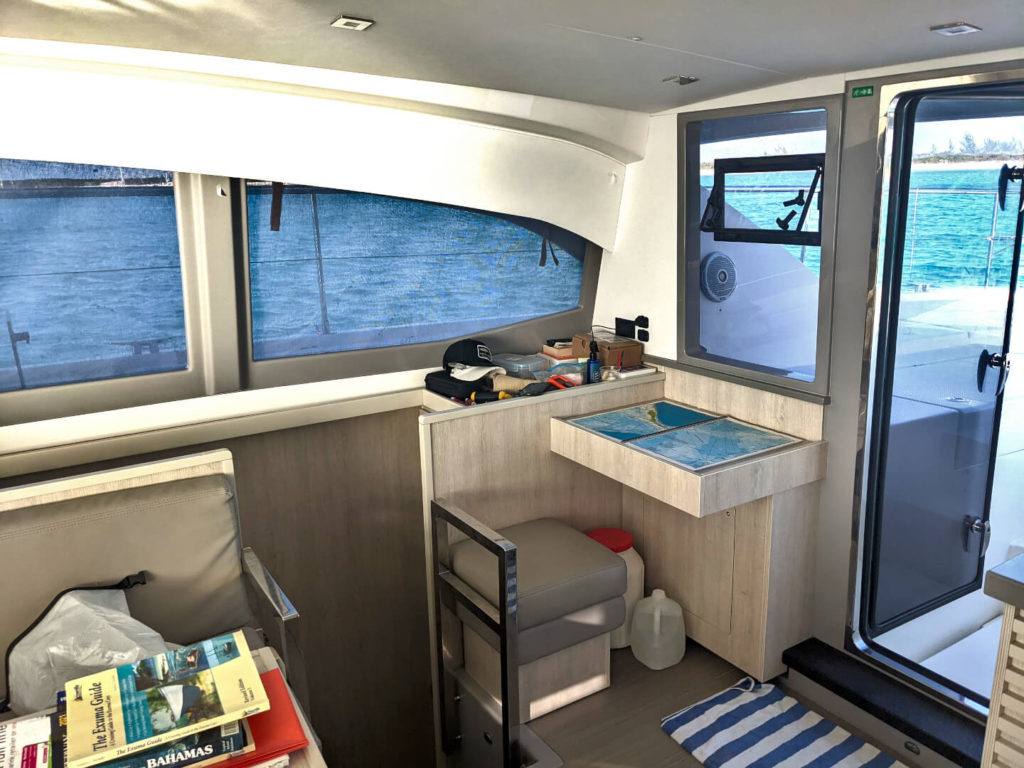
Living Quarters on the Leopard 43 Powercat
The Leopard 43 Powercat comes in two floorplans: the 433 PC is a three stateroom, sometimes called an owner’s layout, as well as a four-stateroom plan, called the 434 PC. The port (left) hull of the 433 has two staterooms fore and aft with a head (bathroom) in between. The starboard (right) hull of the 433 is configured as an “owner’s suite” with a bed at the stern, a larger bathroom forward, and a ‘get ready’ area in the center. In the 434, both hulls are equipped like the port hull in the 433PC, making a four stateroom, two head layout.
Port Living Quarters
When choosing the forward vs aft cabins, each has their advantages. The aft stateroom has a bed with full width end to end and a generous closet. Slightly smaller than a queen mattress, there was ample room for two adults, even if its too hot to get cozy. With the engine beneath the bed and the generator behind the bed, if you aren’t the first to wake up each morning, you’ll be the second.

The forward stateroom has a bed that tapers toward the bow, making it a bit smaller in total. It also has a smaller closet than the aft stateroom. However, it also has an open forepeak area at the foot of the bed that can be used for storage or sleeping small/medium children. The lack of engine beneath the bed here allows two drawers beneath the bunk too.
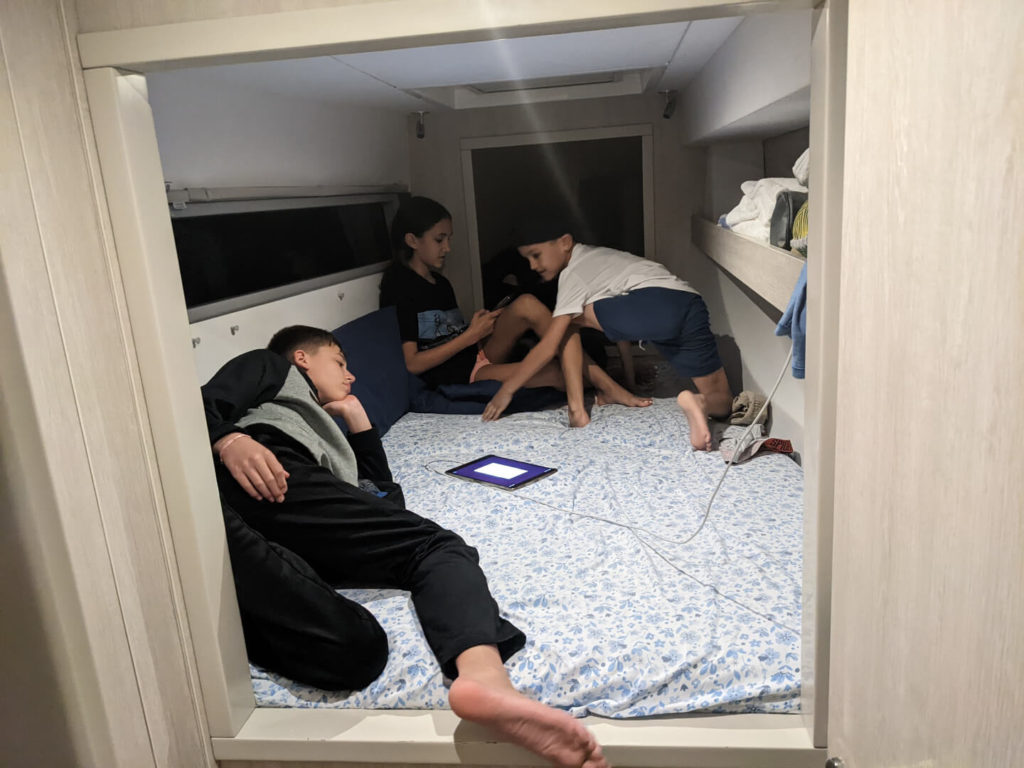
Both staterooms have two shelves that run alongside the bed. They are wide enough to stow emptyish duffle bags, breakables, and charge phones on the well-located USB sockets. Both have locking doors and air conditioning supply ducts. They also both have hatches overhead and to the side, with a fan mounted in front of the side hatch. The aft stateroom has a third hatch at the rear. All overhead hatches have a retractable blackout cover and bug screen. All but one of our hatches still had them entirely intact. The side windows have curtains to cover them. One side window on our yacht was cracked.
Port Head (Bathroom)
The port head (bathroom) has a toilet at one end, a vanity in the center, and a shower with a porthole at the opposite end. There is also a hatch with a screen and shade on the ceiling. A small wastebasket folds out of the vanity where we were instructed to place our buttwipes rather than flushing them since the base does not provide RV toilet paper. There are several hooks for towels and wet clothes. (note that what you hang in the head will smell like the head…raw sewage in our case) All materials are waterproof except maybe the wood veneer pocket door opposite the vanity…that said, the pocket door is a nice touch given the tight space.
The shower comes close to having a true stall but has a flat floor and lacks a door or curtain to enclose it; but at least you don’t have to stand in the shower while using the toilet. The shower wand is height adjustable and removable. The water control is a single lever that turns for temp and pulls for pressure. This makes it easy to pause without resetting the temperature control when taking a navy shower. The drain pump operates automatically as the shower drain fills with water (as long as it is switched on at the breaker panel in the salon). There are several hooks throughout for towels and wet clothes and a ledge with railing in the shower for soaps and bathing supplies. All in all this is a very adequate, if not excellent head for a yacht this size.

Owners Suite
In the Moorings/Leopard 433 PC, the starboard (right) hull houses the “owner’s suite”. The suite includes a bed in the stern that matches the other hull, a long hallway in the center with lots of storage and a desk/vanity, then a large head at the forward end of the hull.

Instead of having a door to the bedroom, there’s a huge sliding piece of wood that closes off the hallway from the salon at the stairs to make one large room. We found two downsides to this design:
- First, opening the slider makes the area very open, so if one person needs to go in and out of the area while their partner is buck naked getting dressed, it’s hard to find a private place to stand while the door is open.
- The other issue is that the air conditioning is far less effective in this layout. The two air conditioning supplies, as well as the return, are all located in the hallway, creating a large space to be conditioned…furthermore, we were trying to cool the bedrooms while leaving all the exterior doors open to the salon. Every time you go in and out of that huge door, you let all the cold air out in this scenario. Aside from that, it is a pretty trick design.
The stern bed on the owner’s side matches the one on the port side.
Owner’s Head (Bathroom)

You’ll think the port head is great until you see the master head on the starboard side. Located in the bow, it has a very generous, fully enclosed shower stall. Even more generous storage in and around the vanity. There are lots of bars and hooks for drying. There’s also a huge cabinet forward of the shower where the V-berth is in the other hull. You can fill that sucker up with anything that can tolerate the bathroom humidity. We used it to store some more rigid bags and boxes, but barely put a dent in the space. The toilet is mounted in the corner behind the swinging door. This allows for plenty of knee room when you need a bit more purchase to get the job done. The fixtures and pumps are the same as the other head, but the hatch is much larger in here.
There’s a 120v outlet at the desk/vanity that can be used to blow dry and curl your hair with the generator on. Note that this outlet is on the galley circuit, so it will conflict with any appliance you might be running at the same time, such as the coffee maker.
Systems on the Leopard 43 Powercat
Air conditioning.

There are two separate air conditioning units that supply each hull and can be set to different temperatures. The port hull has one supply vent in each stateroom and a third in the salon, with the return air in the hallway. The starboard hull (owner’s side) has a supply vent at each end of the hallway, one in the salon and the return air in the hallway. On the port hull, the supply vents are located inside the staterooms.
Closing the stateroom doors on the port hull cooled those small areas very quickly. The large cooling area in the starboard hull, on the other hand, took longer to cool down and gave up its cooling quickly when sliding the giant door open if the yacht wasn’t completely closed. So, the system was most effective with the salon doors closed and cooling the entire yacht. Not a bad thing as some catamarans only have capacity to cool the staterooms. The air conditioners also have a dehumidify setting and can be run in reverse cycle to heat the cabin. You must run the generator or be on shore power to operate the air conditioners.
The yacht is equipped with a 9 KW Northern Lights diesel generator. There is no inverter on these yachts, so any 120v application requires that the generator be running. This includes the a/c, watermaker, flybridge BBQ, kitchen appliances, water heater and 120v outlets. The generator isn’t disruptively loud, but it does rock the yacht a bit when starting; my crew appreciated a warning before firing it up. In cruising service, our yacht had twice as many hours on the genset as the engines. I would welcome an inverter to reduce fuel consumption and running hours when only a light load is needed. However, in charter service, this is likely to result in more severe experience for the batteries.
The fridges, pumps, and navigation equipment all run on 12 volts, allowing them to run off the batteries. With help of the solar panels and regular use of the generator, our checkout skipper said we shouldn’t need to worry about state of charge on batteries. However, we did get a low house battery warning on the Raymarine MFD on our 6th day away from shore power.
The anchor windlass and dinghy davit are both 12 volt, but have a big draw. So, like on most yachts, you should have an engine running to ensure adequate voltage for the motors and reduce wear on the batteries. In the case of the Leopard 43, the port engine carries the charging load and is the one to run.
Our yacht came equipped with a watermaker. Watermakers use a large pump to press saltwater through a high density filter, removing the salt. This process requires a lot of electricity, so the generator must be on to use it. Out islands in the Bahamas use the same type of reverse osmosis systems to make water on shore. Because of this the water hose at the fuel dock is not free. Rather it costs 40 cents or more per gallon, making the generator operation economical, even at $5 per gallon for diesel. However, our checkout skipper spent 20 mins or so tinkering with it and couldn’t get it started. Watermakers are notoriously finicky, so this was not a surprise. The watermaker is located underneath the forward port bed.
The Leopard 43 Powercat comes with two 102-gallon water tanks and two 12-gallon hot water heaters. While the hot water heaters serve each side separately, the freshwater tanks serve the entire yacht and can be switched open separately. This allows you to open one tank at a time, so if you’ve got an overzealous showerer on your crew, they can’t tap both tanks in one shot; giving you an extra day to re-water. With four adults and three kids aboard for a week we refilled the primary water tank after the second morning and did not empty it entirely before returning the yacht. So the total capacity for both tanks would have been sufficient for the week. However, the kids mostly bathed in the ocean and just rinsed off with the fresh-water pump on the stern.
The supply water pump was located in the salon and very quiet, so you won’t wake the crew while washing your hands in the middle of the night. The water heaters were very effective in that we had hot water in the morning before turning on the generator and we never ran out. The automatic shower drains were nice (compared to manual drains), but they were not silent.
The yacht comes equipped with Jabsco electric heads. The Jabsco head is operated with sea water, with one button to fill the bowl before you do your business, and another button to suck it into the holding tank. Most charter yachts, well most yachts under 100 feet, are equipped with a similar system. While a manual pump is very common, electric pumps like this one is considered an upgrade. The electric pump makes it easier to go potty and to rinse the toilet, but might result in filling the holding tanks faster. It’s also harder to rinse the valves with the electric system (read on).
Using sea water for flushing reduces fresh-water consumption. However, that short cut has an unfortunate side effect: the saltwater reacts with your piss to crystalize into a stinky mess. The crystalized saltwater piss builds up on the toilet valves so that, over time, they don’t close. It also builds up in the hoses (making it easier to clog) and in the holding tank (reducing your capacity). Somehow, this cocktail also manages to leech through the hoses and stink up the bilge. If this type of system isn’t serviced after each week of use, this science experiment compounds, leaving the yacht with a perpetual sewage smell and a system that hesitates to accept and contain your waste…like on our yacht.
Like RVs, these systems clog easily, especially with toilet paper. Moorings has charterers supply their own toilet paper and instructs us to put the TP in the wastebasket…not only a hard reflex to overcome, but gross. It would seem more effective for the charter company to supply the yachts with sufficient RV toilet paper, which is what we see when chartering in the Pacific Northwest.

On our yacht, the port tank was full on the first night and clogged intermittently throughout the trip. The starboard head constantly leeched a stream of piss onto the bathroom floor. At one point we got an airlock on the starboard head and it wouldn’t fill the bowl with water. I was able to fix it by closing the seacock, removing and draining the filter, then putting it all back together. Then we only got 3 days out of the starboard head after emptying…then two days. Be sure to empty your tanks every chance you get.
When we returned our yacht to Moorings with a long list of safety issues, they didn’t have much of a sense of urgency, but once the dockhands got word that we had a clogged head, they were down there in a heartbeat. Apparently, the Nassau base policy is that charterers pay $100 cash to whomever unclogs the head. We refused to pay given the issues we had.
If you do get a yacht with a crystalized valve, you can put some vinegar in the bowl and ease a small amount of it into the drain system with a partial flush (easier to do with a manual pump than the electric)…I learned that after returning home from this trip.
Anchor Windlass
Our anchor windlass worked as expected. It is noteworthy in how easy it was to access. The windlass is located in a hatch next to the stairs outside the forward salon door. The remote is stored in this locker with a cable long enough to be walked to the edge of the bow while watching the anchor rode. From these locations it is very easy to look up and speak to the helmsperson on the flybridge.
An anchor bridle spans between the hulls beneath the bow to secure the anchor rode once the anchor is out. You can’t see much of it from the topside of the yacht, so it could be a bit confusing the first time you use it if you don’t have much experience with catamarans. There are no length markings on the anchor rode, so how much you let out will be a total guess. On the bright side, we set the anchor at least a dozen times and never had the chain bind in the windlass or need to fiddle in the chain locker.
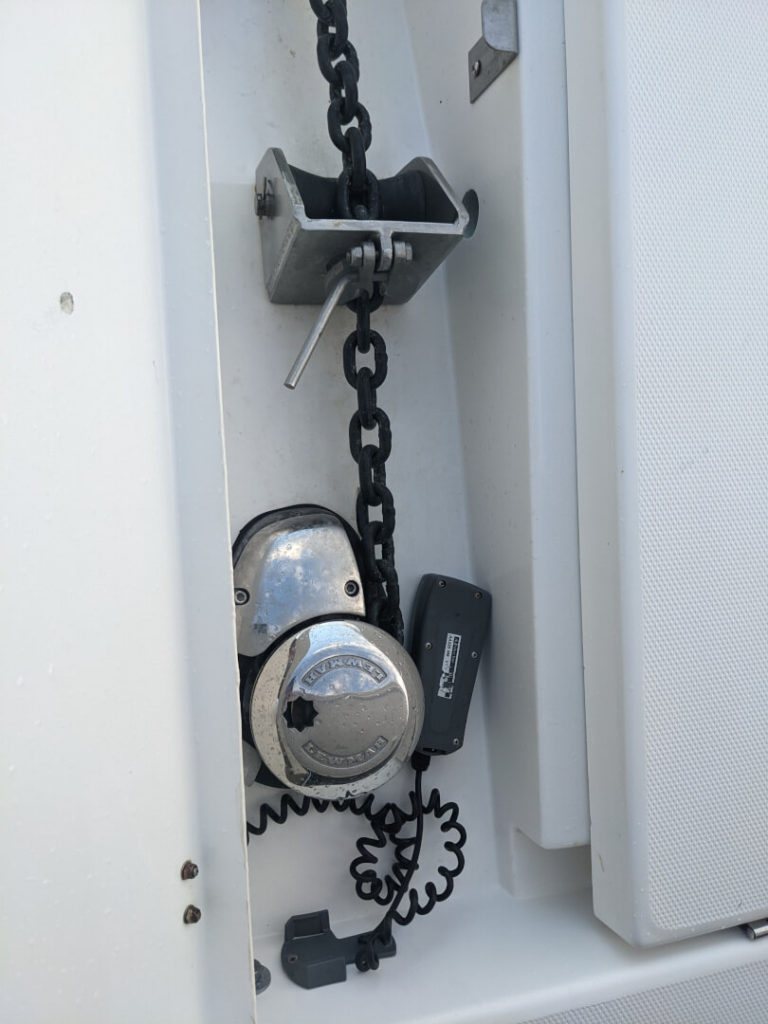
Because the anchor and windlass are mounted 15 or so feet behind the end of the bow, you have to drop the anchor at the windlass, then run up to the edge of the bow to watch while you let chain out, then run back to the windlass compartment to attach the bridle once the anchor is set. From these locations it is very easy to look up and speak to the helmsperson on the flybridge.
Our primary anchor was a big bitchin Delta anchor that dug in real nice. Even when the tide turned in some very shallow water and left us 90 degrees off our original position, the flat, low, wide shank dug into the sand and refused to drag.
Lighting on the Leopard 43 Powercat
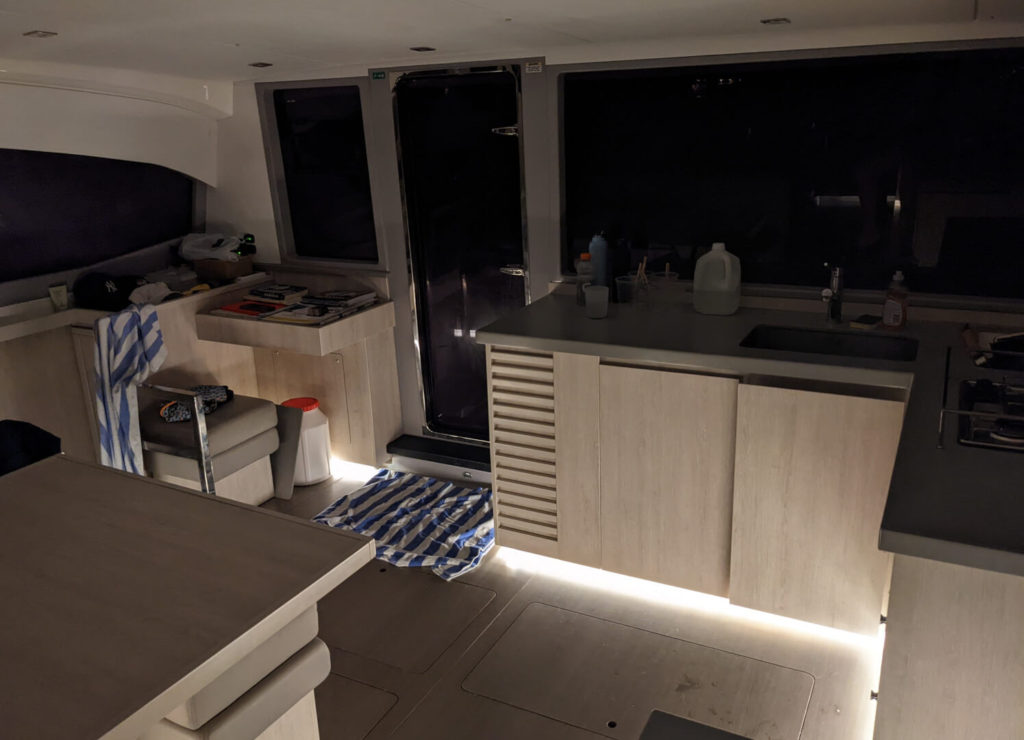
The Leopard 43 Powercat comes with lots of lights to ensure adequate lighting under many circumstances. The light switches were in logical locations mostly worked logically. The salon had three levels of lights, including a set of rope lights under the cabinets. It unfortunately did not have a low nightlight to allow some visibility while kids are sleeping on the settee. The flybridge also had under cabinet rope lights, white lights on the roof, and red lights for use while running at night. However, it did not have running lights to look forward (while in rental service, you aren’t supposed to run at night anyway).
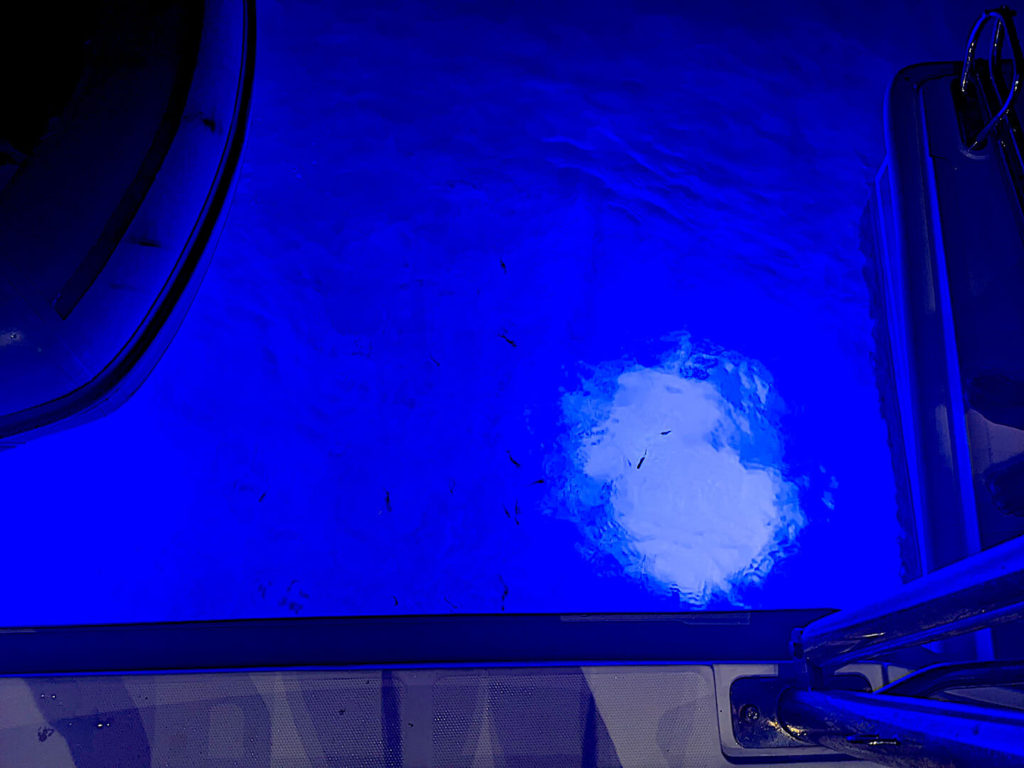
The yach had a set of blue underwater lights that made it easier to find the yacht when approaching with the dinghy at night. It also made for some cool views of the fish after dark and made it easy to confirm our running gear was in good order after we drug anchor and were not sure if we’d run aground. It also ensured we were visible while anchored after our anchor light fell over.
Problems with the Leopard 43 Powercat
Our Leopard 43 Powercat presented a surprising amount of problems on our weeklong bareboat charter. Especially considering our yacht was just over three years old at the time. I’ve already shared the problems we had with the heads, VHF, flybridge enclosure, anchor light, toaster, microwave, propane valve, inflatable life vests, both refrigerators, and the watermaker. So, I won’t repeat them here.
Unfortunately, this doesn’t seem to be an isolated issue. I spoke with a charterer before our trip that had recently gone out in an even newer yacht. He had problems with throttles, gauges, navigation, air conditioning, and the watermaker. I also spoke to the maintenance manager at the base. He acknowledged that the fleet was not being maintained as well as it should be and noted that he was recently hired to help the team start digging out, but was running into challenges.
After I reached out to The Moorings three times over 5 months, they responded with an apology and a credit for $1,304 towards our next charter, valid for three years. They did not offer an explanation or note whether conditions in Nassau have improved. In their defense, I think their customer service team got slammed dealing with other issues in the British Virgin Islands . I reached out to their press team for an update on these issues, but have not received a response.
The Moorings set us up with a sweet dinghy on our charter. It was a 10-foot RIB with a 25-horsepower motor. While it was rated for 5, we had plenty of room (and didn’t sink) with a crew of 7 and were still able to kick up a wake. While a 10-horsepower motor is more common on dinghies of this size, the transom was rated for 25 and it really did get us to shore nice and quick.
One day when I was in the dinghy alone, going into a bit of wind, I throttled up and the bow came a at least 5 feet out of the water, almost flipping the boat end over end! One disappointment that’s common outside the US is that it was a two-stroke engine. Two-strokes, if you don’t know, lose some unburned gasoline in the exhaust and ultimately into the water; they’re also less efficient and stinky. Worse yet, ours wasn’t delivered with a full fuel tank, so we had to fill it during our cruise and buy a full quart of two stroke oil (for $20!) to make the fuel mix.
The dinghy came equipped with a folding grappling anchor on a floating line (behind a bit of chain). While grappling anchors fold down nice and compact for storage, they really need rocks to bite, so it was useless at holding us in the sandy bottoms of the Bahamas. Additionally, the shackle pin was not installed tightly and fell out while we were using it.
If your itinerary includes regular use of a dinghy, (if you are anchoring or using mooring balls, it does), having a dinghy davit is a #GameChanger. Without a davit, you have to tow your dinghy. That means you’ve gotta remember to pull it in and keep the painter out of the prop while docking, and possibly remove the outboard while underway. Not docking? You’ll still need to bail the water out of it after towing. The Leopard 43 Powercat has a davit on the stern that makes it a cinch to launch and retreive the dinghy.
Bareboat Charter Equipment from The Moorings
The Moorings equipped our charter yacht with a strong supplies list. The kitchen was well stocked with storage and mixing bowls, plenty of cups, plates, bowls and cutlery for a crew of eight or more.
Navigational manuals included the top guides for our cruising grounds in the Exuma Cays: Explorer Charts and Pavalidis’ The Exumas Guide . The binoculars on the other hand were hilariously worthless. They were marked as 7×50 (meaning 7x magnification) with no brand name and weighted almost nothing. However, I don’t think they were even 2x magnification. Fortunately, we brought our own 7×50 binoculars which not only served to confirm there was something wrong with these, but allowed us to use binoculars, you know, when we needed them.
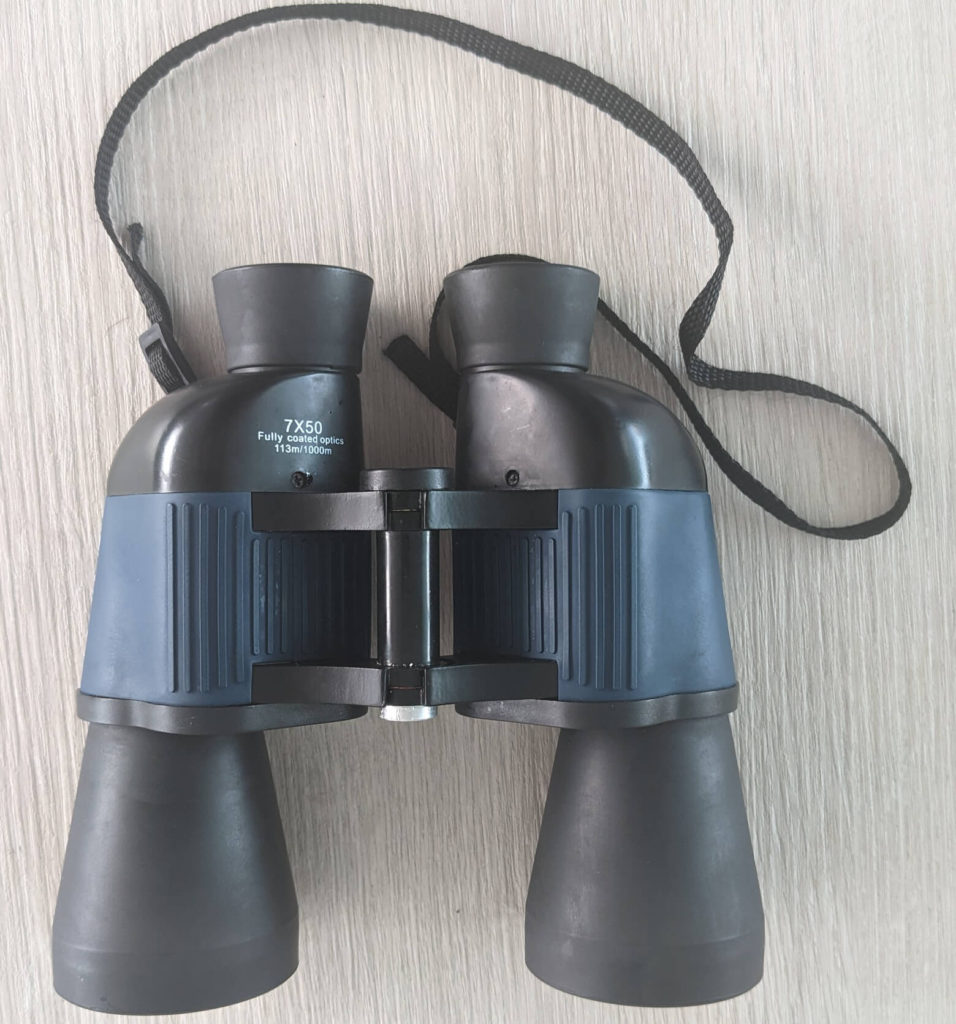
A full kit of inflatable life jackets was a welcome luxury compared to many charters with gross, old, ill fitting life jackets. However, as we learned, don’t trust a borrowed inflatable until you’ve verified that it is properly armed. Our yacht came with twice as many rearm kits as lifejackets, as well as safety harnesses beneath the salon settee. There was also a set of snorkel vests in the bow, which provided an extra level of safety when we ventured out with dive weights on. Snorkel vests are uninflated vests that you can self inflate if you run into trouble by blowing into a straw.
The toolkit consisted of two spare impellers (that we were told not to try to replace oursleves), spare fuses, spare hose clamps, a can of WD-40, a huge flathead screwdriver, phillips screwdriver, one allen wrench, and channel locks. Fortunately, we didn’t need it.
A plastic dry bin for the dinghy held some flares, and a flashlight.
Aside from the weak toolkit and lack of any working VHF, the other piece of kit we really would have liked to have was a broom and dustpan, or vacuum. The floors got pretty gross with a week of tracking sand through the yacht.
Features to Look For in a Leopard 43 Powercat
Options on the Leopard 43 Powercat are relatively limited, and when chartering from The Moorings, you from the fleet, not a specific named yacht. Your only choice is age. That said, the optional flybridge refrigerator makes for more food storage, which allows for more thorough provisioning up front. Depending on cruising grounds, this can save money and stress…or just eliminate the need to scurry down to the salon for bevvies while under way. The larger engines that our yacht was equipped with probably run a bit faster and eek out a few extra MPGs. Unfortunately, its a roll of the dice as to whether you’ll have these features on your charter.
The optional watermaker didn’t work on our charter, which is not surprising for watermakers. However, we would have welcomed it given the cost of water in the Exumas. In most cruising areas with access to water, it won’t be worth the fuel to operate a watermaker…and they don’t make water fast enough to take longer showers, so don’t think that’s an option!
How Much Does a Leopard 43 Powercat Cost and Where Can I Rent One
The shallow 3’1″ foot draft of this yacht allowed us to run up and down the shallow banks of the Bahamas’ Exuma Cays and anchor in some tight bays with confidence. These yachts are also available in The US and British Virgin Islands, Greece, The Seychelles, and Saint Lucia.
As of this writing, there are some dates available to charter the four stateroom 344 PC for as low as $3,700 of the three stateroom 433 PC for $3,900. At the other end of the spectrum, there are spring dates in Nassau currently listed for as much as $16,000. These yachts are also available in The US and British Virgin Islands, Greece, The Seychelles, and Saint Lucia.
Alternatives to the Leopard 43 Power Catamaran
If you like the general design of the Leopard 43 Powercat, but want to sail. The Leopard 40 will scratch that itch for 25-25% less in charter fees ($1k-$4k). Leopard has discontinued these models in favor of the Leopard 42 [sail] and (in 2023) the Leopard 42 Powercat. The new 42s have twin heads on the guest stateroom hull that likely comes at the expense of storage and the forepeak berth. Expect Moorings to keep the old models in bareboat charter for another five years while they’re slowly phased out in favor of the new models.
If you are looking to double down on the condo-cat vibe and rent something a bit more pontoony , Marine Max runs a charter fleet in the British Virgin Islands that is right up your alley. The 443 has a full beam owners suite and three heads with fully enclosed showers.
How Much Experience Do You Need to Rent a Leopard 43 Powercat
The good news is you don’t need any sailing experience to rent a powercat. However, your charter company will probably want you to have twin engine experience. Our checkout skipper did not expect us to be able to dock the yacht or maneuver within the tight Palm Cay marina. Depending on your comfort level, the checkout skipper can tow an extra dinghy out of the marina and use that to get back after setting you off; call the base and they’ll do the same in reverse. In addition to twin engine experience, you’ll need to be comfortable operating a similarly sized yacht (The Moorings will say +/- 5 feet) and have experience with the challenges of the particular cruising area you’ll be in.
A good friend of mine says sailing is about the journey, and powerboating is about the destination. My Spring Break Busy Boater crew was east bound and down: a long way to go and a short time to get there. The Exuma Cays were filled with cool stuff we wanted to see and do during the one week we had, and the powerboat speed was the insurance policy to get it done.
The generous storage, tankage, and electrical systems neutralized the lack of infrastructure for fueling, watering, docking, and provisioning in the Exumas. The vast living space on the Leopard 43 Powercat ensured that two families with three children ended the trip as friends. As long as we stayed on the calm West side of the Exuma Cays where our condo-cat was comfortable and forgot about the pee smell and lack of ability to call for help, the whole crew enjoyed the great weather and beauty of this unique part of the world.
However, I can’t ignore the fact that we missed out on the opportunity to hoist the sails in one of the most idyllic sailing destinations in the world with strong trade winds crossing calm, protected waters. The powerboat speed also comes at a price premium of $1k-$4k in additional weekly charter fees and, for the distances in the Exumas at $5/gallon, $700-$1,000 in additional fuel for the week, depending on how much sailing you missed out on.

- Subscribe Now
- Digital Editions

VIDEO: Leopard 43PC review
A wholesale update of the 39PC, the new Leopard 43PC proves itself as one of the best small power catamarans on the water
The Leopard 43PC is an updated version of the 39PC, though it is an update far more comprehensive than a quick facelift and some new engines.
No, from the hulls upwards the 43PC is different to its predecessor and had been desinged from the off to be a power cat.
This translates to the performance where, thanks to a pair of 260hp Yanmar diesels, the 43PC will top out at over 20 knots. Conversely, throttle back to 6 knots and the range rockets to nearly 1,500 miles.
Some of the biggest changes come on deck where the orientation has totally changed and Leopard have added a door at the front of the saloon to the vast foredeck.
The flybridge is also much improved over the 39, with a far better layout and access from the cockpit and a gate forward.
Below deck you can either have four double cabins sharing two bathrooms (prime charter spec) or a full-length master in one hull with two guests cabins in the other.
Power catamarans certainly aren’t for everybody but if you’re in the market then the 43PC is a cracker.
Read the full report in the September 2016 issue of MBY .
- Boat Reviews
- Press Releases
Leopard Catamarans Blog
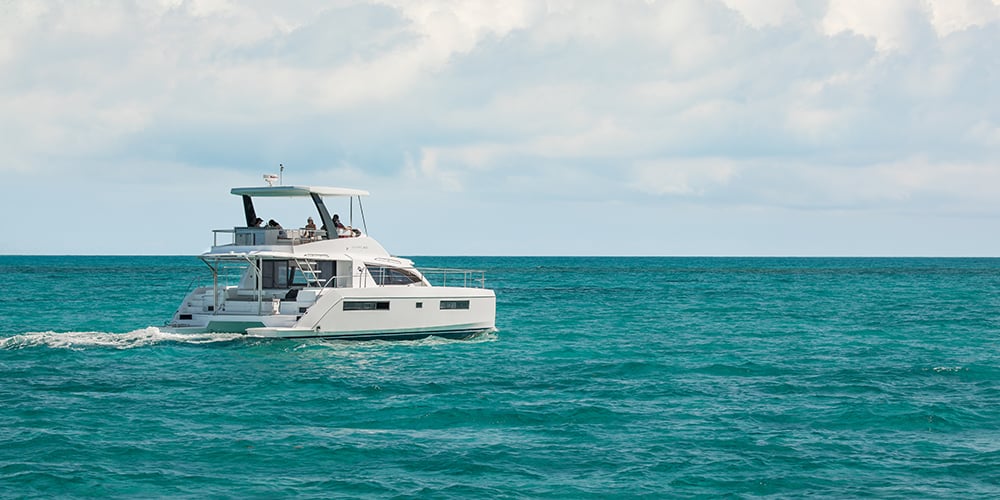
How One Powercat Owner Started a Multihull Trend
Owner Stories , Leopard 43 PC
'There is always a different explanation for how each of our yacht owners decided to buy a Leopard Catamaran. For the owner of Arrgh Boat, a Leopard 43 Powercat, Ron Buck and his wife followed the path to ownership in a way many of our owners do....

Around the Point: A Sunshine State of Mind Delivery
Deliveries , Leopard 43 PC
If you have spent years delivering power and sail cats on their own bottom from Cape Town to the Caribbean and Florida, then perhaps delivering a Leopard Powercat from Fort Lauderdale to Tampa might sound more like a vacation to you and less like...
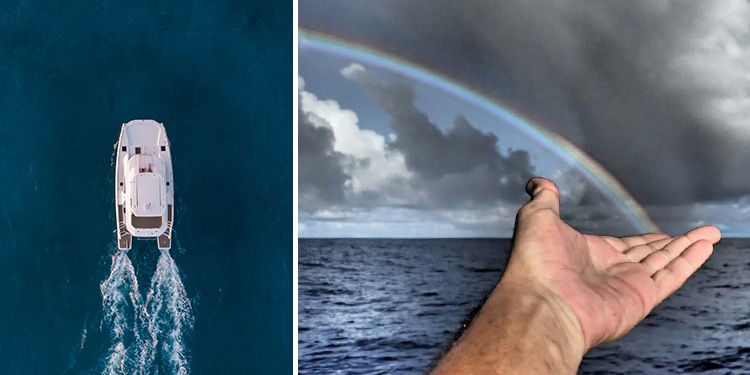
Cape Town to Brazil on a Leopard 43 PC
Whether it is your first time or your one-hundredth time, completing a voyage across the Atlantic is always an accomplishment. Losing site of land can be terrifying yet exciting at the same time. It is the thrill of the unknown. Anything could go...
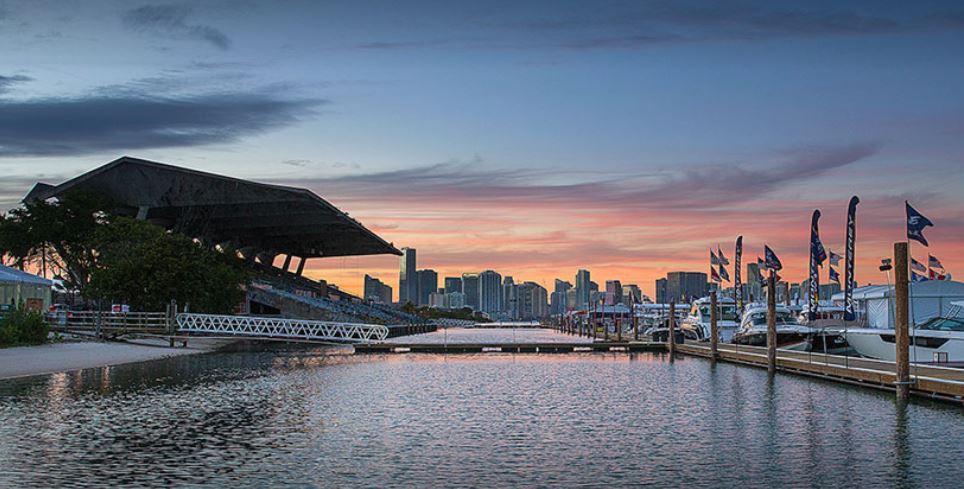
Join Us in Miami
Boat Buying Process , Leopard 51 PC , Leopard 43 PC , Leopard 40 , Leopard 50 , Leopard 45 , Leopard 58
This February the Miami International Boat Show will be the place to be! For the first time ever we will be showcasing our entire fleet of Leopard Catamarans in one place, including that all-new Leopard 50. Be one of the first people to see the...
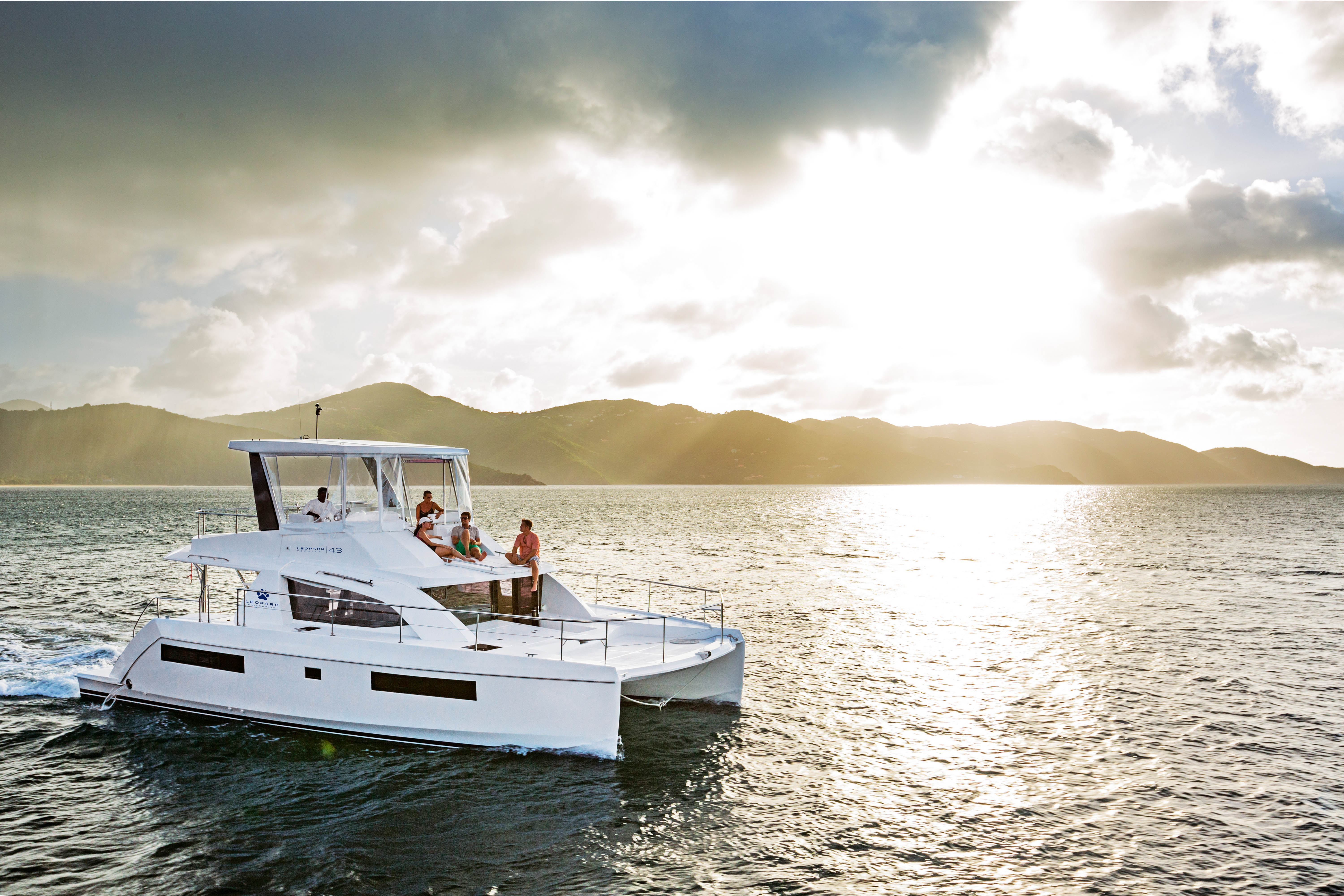
The Top 10 Advantages of Owning a Leopard 43PC
Product Details , Leopard 43 PC
The Leopard 43PC is a powerful, well-balanced catamaran. She represents the future of power boating. But do you know the advantages to owning the Leopard 43PC versus other powercats on the market that are of comparable size? The truth is, they don’t...
Posts by Tag
- Owner Stories (57)
- Boating Tips (31)
- Boat Buying Process (18)
- Product Details (15)
- Leopard 45 (12)
- Leopard 48 (12)
- Deliveries (10)
- Leopard 50 (9)
- Leopard 40 (8)
- Leopard 51 PC (7)
- Leopard 43 PC (5)
- Leopard 39 (4)
- Leopard 44 (4)
- Team Leopard (4)
- Leopard 42 (3)
- Leopard 46 PC (3)
- Leopard 53 PC (3)
- Leopard 58 (3)
- News from the Factory (2)
- Owner Privileges (2)
- General news (1)
Great choice! Your favorites are temporarily saved for this session. Sign in to save them permanently, access them on any device, and receive relevant alerts.
- Sailboat Guide
Leopard 43 is a 42 ′ 5 ″ / 13 m catamaran sailboat designed by Simonis Voogd Design and built by Robertson & Caine between 2004 and 2007.
Rig and Sails
Auxilary power, accomodations, calculations.
The theoretical maximum speed that a displacement hull can move efficiently through the water is determined by it's waterline length and displacement. It may be unable to reach this speed if the boat is underpowered or heavily loaded, though it may exceed this speed given enough power. Read more.
Classic hull speed formula:
Hull Speed = 1.34 x √LWL
Max Speed/Length ratio = 8.26 ÷ Displacement/Length ratio .311 Hull Speed = Max Speed/Length ratio x √LWL
Sail Area / Displacement Ratio
A measure of the power of the sails relative to the weight of the boat. The higher the number, the higher the performance, but the harder the boat will be to handle. This ratio is a "non-dimensional" value that facilitates comparisons between boats of different types and sizes. Read more.
SA/D = SA ÷ (D ÷ 64) 2/3
- SA : Sail area in square feet, derived by adding the mainsail area to 100% of the foretriangle area (the lateral area above the deck between the mast and the forestay).
- D : Displacement in pounds.
Ballast / Displacement Ratio
A measure of the stability of a boat's hull that suggests how well a monohull will stand up to its sails. The ballast displacement ratio indicates how much of the weight of a boat is placed for maximum stability against capsizing and is an indicator of stiffness and resistance to capsize.
Ballast / Displacement * 100
Displacement / Length Ratio
A measure of the weight of the boat relative to it's length at the waterline. The higher a boat’s D/L ratio, the more easily it will carry a load and the more comfortable its motion will be. The lower a boat's ratio is, the less power it takes to drive the boat to its nominal hull speed or beyond. Read more.
D/L = (D ÷ 2240) ÷ (0.01 x LWL)³
- D: Displacement of the boat in pounds.
- LWL: Waterline length in feet
Comfort Ratio
This ratio assess how quickly and abruptly a boat’s hull reacts to waves in a significant seaway, these being the elements of a boat’s motion most likely to cause seasickness. Read more.
Comfort ratio = D ÷ (.65 x (.7 LWL + .3 LOA) x Beam 1.33 )
- D: Displacement of the boat in pounds
- LOA: Length overall in feet
- Beam: Width of boat at the widest point in feet
Capsize Screening Formula
This formula attempts to indicate whether a given boat might be too wide and light to readily right itself after being overturned in extreme conditions. Read more.
CSV = Beam ÷ ³√(D / 64)
Mainsail area: 76 m². Genoa area: 44 m². Engines: 2 x 29 hp diesels Most built for the charter trade. Owners version available (13) with different layout.
Embed this page on your own website by copying and pasting this code.
Discover Related Sailboats

YouTube Stars
YouTube sailing channels allow millions of us to experience the adventures of the high seas without casting off our own lines. We get an ...
- About Sailboat Guide
©2024 Sea Time Tech, LLC
This site is protected by reCAPTCHA and the Google Privacy Policy and Terms of Service apply.
CatamaranReviews.com
Leopard catamarans.
Leopard got it’s start in 1994 when South African boat builder Roberts and Caine partnered with charter company, The Moorings to build charter catamarans. Due to the popularity and durability of the catamarans built by Roberts and Caine, the Leopard Catamaran brand was formed in 2000. Leopard Catamarans builds spacious and durable cruising catamarans that are ready for coastal and offshore sailing. More than 1,000+ Leopard Catamarans have been built and used around the world in The Moorings, Sunsail and Footlooses extensive charter fleet. Prices for a Leopard Catamaran vary from $150+ for a used Leopard 38 to 1.5M+ for a Leopard 58. For prices of a new Leopard please contact Leopard Catamarans or an authorized Leopard dealer.
Leopard Models
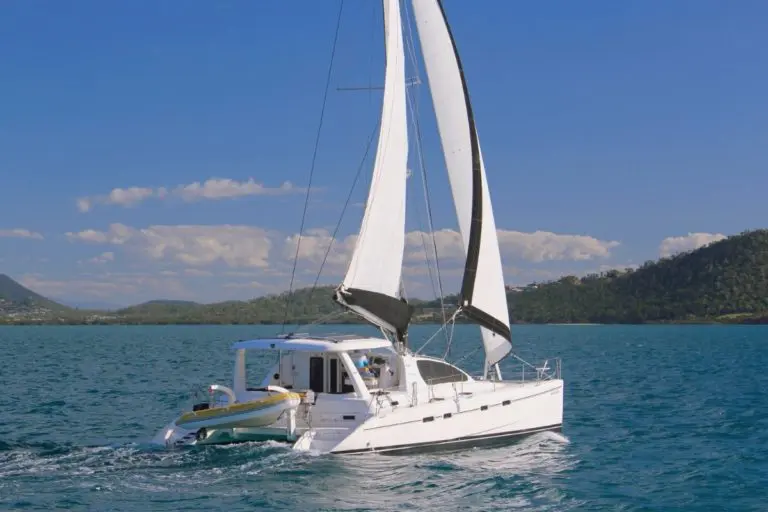
The Leopard 43 is a popular cruising catamaran. The well thought out, comfortable design, and ability to sail short-handed makes an ideal blue-water cruising boat. Built with a high standard of construction, they are good value for money on the used catamaran market. DESIGN – INTERIOR & EXTERIOR The Leopard 43 is a comfortable and reasonably fast passage maker able to be sailed short-handed. Based on the award-winning Leopard 42, the Leopard 43 is designed by Simonis and Voegd and built by Robertson and Caine, a large South African builder. These catamarans were built in two configurations, one for owners and one for the charter market. The owner’s version, called the Leopard 43 has three cabins and three heads. While
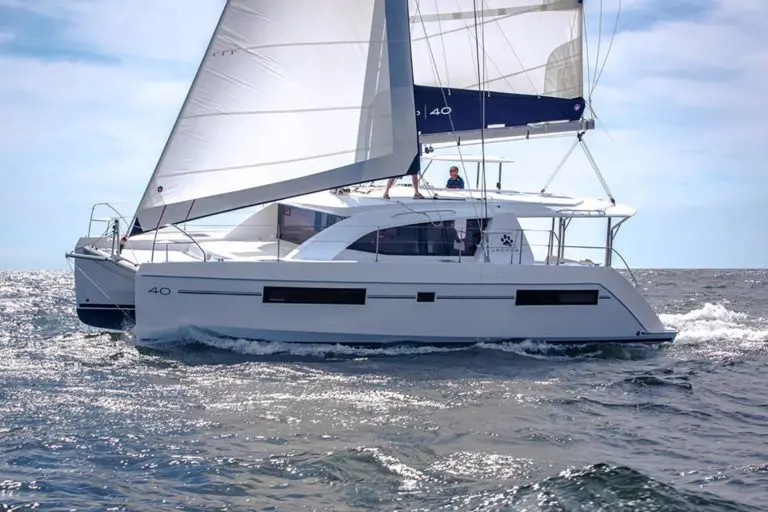
The recently redesigned Leopard 40 sports an increased interior volume and modern interior layout. A unique saloon to bow access door gives easy access for sunbathing and chilling out on the deck. With a bright and uncluttered design and a helm with excellent visibility, the Leopard 40 provides the safety expected for the bluewater lifestyle in a comfortable package. DESIGN – INTERIOR & EXTERIOR Designed and built by South African firm Robertson & Caine and along with Naval Architects Simonis-Voogd, the Leopard 40 attempts to set a new standard for cruising catamarans. Based on customer and owner feedback, the most recent Leopard 40 has a redesigned configuration. As an evolution of the Leopard 39 design, the increase in hull volume,
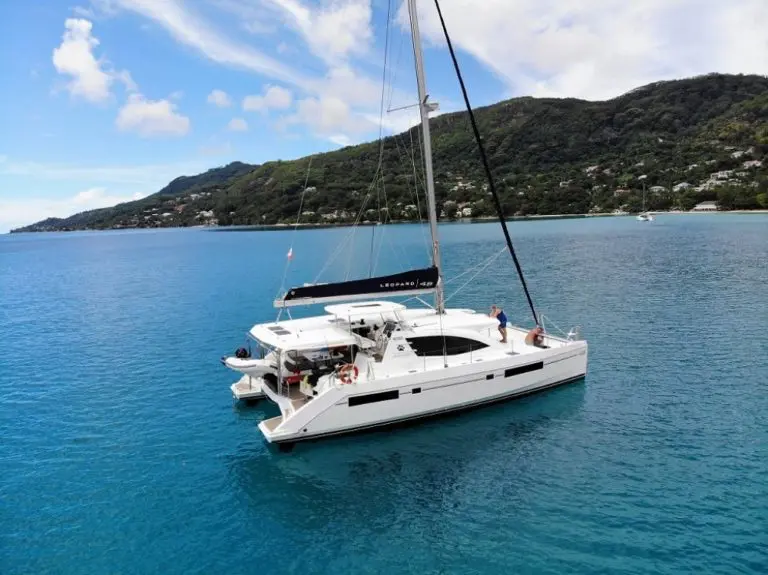
Winning the Boat of the Year Award in 2013, the Leopard 48 set new standards for cruising catamarans by not only offering a large floor plan but also twin cockpits with its sleek design. By launching the Leopard 48 in replacement of its most successful 46-footer, the catamaran company incorporated the feedback received from yacht sailors and paid close attention to improve the seaworthiness of the vessel. DESIGN – EXTERIOR & INTERIOR The Leopard 48 catamaran is a product of South African builder Robertson and Caine and naval architects Alex Simonis and Voogd. DECK Boarding the Leopard 48 from the wide transom platform is easy and comfortable. First witnessed in the Leopard 44, the twin cockpits of the Leopard 48
Catamaran Makes
New reviews, most popular.

SAILING BLOWN AWAY
- Nov 22, 2020
Why We Bought a 2015 Leopard 44 Catamaran - Tame the Cat
My wife Eileen and I searched Leopard catamarans almost exclusively because they represent a combination of blue water cruising capabilities with production efficiencies. In other words, they were a good affordable catamaran to sail around the world. As proof of their seaworthiness, most have been delivered to their owners by sea from Cape Town, South Africa either by their owners or a delivery captain. Because of their outstanding reputation, we also considered the 450 Lagoon; however, we steered away from them mainly as a result of their fly bridge helm positions which we think is less ideal for ocean crossings.
WHY WE CHOSE THE LEOPARD 44 OVER THE 39, 40 AND 48
Check out our Leopard catamaran's video below on our first day touring Leopard catamarans with our buyers broker Bill Regan and be prepared to be entertained and informed of the specifics on why we chose the Leopard 44 and in the process learn more about the rest of their line.
On this crazy busy day, we toured a 2014 Leopard 39 and were glad we had rescinded on our contract last spring on one in the Moorings / Sunsail Belize fleet. We loved it's design, price ($215K) and sailing reputation; however, it was too small for us as a full time home. For someone who lived in Ft. Lauderdale and took one to two-week sailing trips to the Bahamas this would definitely be a boat to consider.
After we let go of the 39, we latched onto a 2018 Leopard 40 ($225K) with contract that had been damaged and repaired in Irma and included had a new mast, boom, standing rigging and generator and we by far the cheapest of the limited Leopard 40 lot being phased out by Moorings / Sunsail. After having toured it, we realized that it too was too small for us as a live aboard and in addition we were leery that there might be some undetected trauma from from Irma that might compromise our blue water safety so we released that contract also.
Reluctantly we drove 2 1/2 hours north of Ft. Lauderdale to the Ft. Pierce Marina where we looked at a 2015 Leopard 44 with owners cabin on the hard for sale for $575K which was MUCH more than we were willing to pay but at least we could see the layout. Initially, we didn't like this model because we thought it has wet bathrooms but were soon relieved to find that that wasn't the case and were delighted to discover the front cockpit whose innovation catapulted this popular sized 44 footer to a dual "Best Boat of Year" fame with both Sail Magazine and Cruising world in 2012. Most importantly it seemed to have enough from for our new permanent life at sea and was affordable purchasing from Sunsail Charters for $315K on a model we found in St. Lucia so we quickly placed this cat in a cage with a contract on an no hurricane damaged model which had just been released from the Grenada Sunsail fleet and was heading to Sunsail St. Lucia to undergo phase out repairs.

Make sure you also click on the following links to read critical reviews about this special boat:
Sail Magazine - May 2011
Cruising World - December 2011
Boats.com - July 2011
Ultimately, the Leopard 44 was the boat we chose, but let's learn more about the Leopard 48 which we REALLY liked and the main reason we did not chose it.
We loved the Leopard 48 because it was so enormous compared to the previous one and almost seemed to be as large as our apartment in China. Not only did the rear cockpit seat 10 and have plenty of room for all of our water toys, but the combined saloon and galley with nav station was cavernous and in our opinion, leaving nothing to be desired. Add to that a large front cockpit and full size rooms and bathrooms in the hulls, this cat had us in a trance and all we wanted to do was to stroke and pet its luxurious fur while it purred with delight. Our only issue was that the price on these are mid $450K for the cheapest non hurricane damaged and older with the medium cherry veneer interior which we liked the least and will touch on a bit more later. That extra $135K+ represented a lot of cruising kitty (perhaps 3 years) and this being a larger cat means that both repairs, upkeep and insurance are all part of what comes with owning this pampered puss. Add to that the opportunity cost of investing what we save in a lively stock market over the next 5 to 10 years, and the price of this one increases way more than we care to spend especially when the Leopard 44 has everything we need, albeit it's smaller size.
At the end of the video, we tour the Leopard 58 which was due to be surveyed the next day. As you can see from our comments and reactions, it was pure joy touring this regal feline because the 58 was an ocean palace nicer than most homes, but just way out of range for our pocketbook and limited knowhow.
DESIGN AND COLOR
One of the reasons we LOVE and chose the 2015 Leopard 44 year is that it was the first year of only two years (2015 & 2016) out of seven years total that the Leopard 44 was made which incorporates the new modern sophisticated, yet casual light gray aged driftwood interior which is now standard on all Leopard catamarans which certainly inspired by Restoration Hardware's sophisticated modern, yet casual neutral shaded gray color pallet. Also special, as shown below, is the generous use of LED lighting which makes the salon below sparkly, dazzling and uplifting as well as easy on the energy being supplied by DC power. The pre 2015 versions with the traditional medium cherry cabinetry and finish just seemed too outdated and spending an extra $15K for this new boat and overall look and feel was totally worth if for us. In addition, we think it will eventually add to its resale value.

INSIDER INFORMATION FROM EXPERIENCED SUNSAIL TECHNICIAN
Once we arrived in St. Lucia and took possession of our boat, we was further reassured of buying Leopard after talking with Moorings / Sunsail St. Lucia base long term employed technician affectionately nicknamed "Small Change".

This beloved senior maintenance manager of 35 years is chief Leopard tamer and is master of the ins and outs of Leopard repair and maintenance. I mean, he even meets with senior management and technicians of Leopard South Africa to provide valuable feedback that help Leopard's renowned manufacturer Robertson and Caine make manufacturing improvements to future models that will require less maintenance, ultimately leading to less warranty work and resulting in unnecessary repairs from busy bases saving both time and money for everyone. For these reasons, I really trusted and took to heart every nugget that left his mouth.
WHY VERY FEW LAGOONS ARE IN THE ST. LUCIA FLEET
First, he said their company used have a lot of Lagoons in the fleet but switched to Leopards almost exclusively because of their improved build quality and performance. Leopards more narrow stepped hulls allow them to perform better under sail and overall they require less maintenance over their charter tenure.
HOW THE LEOPARD MODELS COMPARE - BUILD QUALITY
When asked to rank his favorite Leopard catamaran models, Short Change pays with big bills as he draws from his wellspring of experience and knowledge that goes back to Robertson and Caines inception back in 1991. He ranks his favorite Leopard models by build quality and gives the following reasons.
In his opinion, the best made Leopard (10 out of 10) is the Leopard 43, known to Moorings as the 4300 and made famous by Nicki and Jason Wynn of the popular YouTube channel Gone with the Wynns has the highest quality build in the history of the company with regards to hull strength.
In addition the Leopard 46, made from 2006 to 2012, is a 10 out of 10. Not affected by the devastating Irma, St. Lucia has more in use than any other base in the world so he should know.
I was happy to know that he considered our Leopard 44 an 8 out of 10 with regards to build quality and used the fact that most all along with the older models such as the 43 have been delivered at sea by a delivery captain and then put to grueling charter use and then sold to private owners.
When asked about the Leopard 48 and current, Leopard 40 and 45 he gives them all a 4 out of 10 backing that up with the assertion that they now are almost exclusively delivered from the factory to their owners by ship because they cannot stand the grueling 7700 mile sail without substantial repairs before delivered to the owner. It seems that possibly the bean counters have taken over in their attempt to balance new design innovation with profitability.
Recent Posts
Escape From Guatemala - Sailing to Honduras.
Marine Diesel Fuel System Tank - Contamination & Corrosion Cause & Effect - Detailed Explanation
How We Got Live-Aboard Boat / Yacht Insurance with NO Boating Experience
Great video's and content.
Could you give some background around the phase out process offered by Sunsail? What is included in the package? Is there a guarantee/warranty provided? I assume one of the downsides of ex charter is engine hours - would they replace the engines?
Also, do they install the upgrades such as water-maker, AIS etc. or do you need to get private contractors to do the install/upgrades?
How much budget would you suggest be allocated to making the yacht blue water cruiser ready post leaving the charter fleet?
Would Sunsail offer financing or is that up to the buyer to arrange?
Many Thanks
Hi Anthony,
Great questions. Apologies for the delay in answering.
Basically you are buying a boat with cash from Sunsail and your quality protection is your surveyor's survey so make sure you select a good one because they're are no warranties.
All additional upgrade will be done by a private contractor or yourself because those are beyond the technical and parts capability of the Sunsail base.
Make sure you don't buy too large of a boat because if you are going to have a lot of quality upgrades done, you have just began to spend. In all, we have spent $125k for the upgrades show on our site https://www.sailingblownaway.com/faq in addition to the ones below:
stainless solar arch
stainless scuba…

IMAGES
COMMENTS
The market price of the Leopard 43 is in the range from $275,000 to $375,000 depending on the condition and version. CONCLUSION. Overall, the Leopard 43 is a thoughtfully designed catamaran, and the ability to sail short-handed makes it an ideal blue-water cruising boat.
January 16, 2017. Power catamarans like the new Leopard 43 pc are a fast-growing segment of the boating market. Combining speed, fuel-efficiency, comfort, and easy handling, there's much to like—but I wanted proof. So, eschewing the usual single-day boat test, I chartered a Moorings 433 (a Leopard 43 pc with three cabins) for a full week in ...
The Léopard 43 is the development of the Léopard 42, designed by Alex Simonis and Voegd Design. It is offered by the builder in an owner's or Léopard version as well as a charter version, under the name Moorings 4300. The boat we were offered for five days in the West Indies was the latter version…. With varied conditions, up to 35 knots ...
The Leopard 43 is built in a balsa/glass/polyester sandwich. Only the deck-hull joins, the chines and the skeg keels are in monolithic. The deck/hull connections are glued, bolted, and laminated at strategic points. The bulkheads are glued to the hulls. The core is made of balsa, chosen over foam because of its resistance.
ties, the Leopard 43 PC is at a point where it can benefit from the direction the market is taking. We were able to try one out on a nice trip in the Mediterranean. LEOPARD 43PC 90 A Power Cat full of energy Nicely-drawn lines with a successfully integrated flybridge Even with this amount of chop, the Leopard 43 PC's trim is perfect g TEST g
Power Catamarans like the Leopard 39, 43, and 53 are mid-sized catamarans featuring the stepped hull design. This allows for more accommodation space without decreased yacht performance, tremendous speeds -up to 24 knots ( 44.4km/hr) - and outstanding fuel efficiency.
Sailing with his wife and five kids ages 6 to 18 on a Leopard 43. Sailing out of San Diego and preparing to head offshore. Tusitala is the nickname of author Robert Louis Stevenson and means "teller of tales.". Chose Leopard 43 because of space and affordability. He considered monohulls but accommodations were smaller and did not like heeling.
Alternatives to the Leopard 43 Power Catamaran. If you like the general design of the Leopard 43 Powercat, but want to sail. The Leopard 40 will scratch that itch for 25-25% less in charter fees ($1k-$4k). Leopard has discontinued these models in favor of the Leopard 42 [sail] and (in 2023) the Leopard 42 Powercat.
powercat, not a doctored sailing cat. That is a crucial point about the 43; it's not merely a case of stretching the 39's hulls and adding power to give the illusion of a brand new boat - this is a brand new boat. The hull mouldings are new and it has different engines and improved performance to match. Spec
The Leopard 43 PC is an evolution of the breed, ... In 2000, the Leopard brand sail cats started. Leopard built its first power catamaran in 2007, the 47PC, and quickly followed with the 37PC. ... Leopard Catamarans and the Moorings are both owned by Travelopia, which is owned by global investment firm KKR.
A wholesale update of the 39PC, the new Leopard 43PC proves itself as one of the best small power catamarans on the water. The Leopard 43PC is an updated version of the 39PC, though it is an update far more comprehensive than a quick facelift and some new engines. No, from the hulls upwards the 43PC is different to its predecessor and had been ...
The beam of the Leopard 43 Powercat measures twenty-two feet and one inch. The LWL is forty feet and ten inches. The draft is three-foot and one inch and the LOA is forty-two feet and eight inches. The Leopard PC 43 uses 2 two hundred twenty horsepower motors to power itself through the water. The fuel tank can hold two hundred sixty-four gallons.
3. Speed and efficiency. The new hull design of the Leopard 43PC amplifies speed and agility. With narrower hulls and less wetted surface below the waterline, the Leopard 43 PC reaches a maximum speed of 24+ knots (27 MPH) and maintains exceptional fuel efficiency consistent with all Leopard power catamaran models. 4.
The Top 10 Advantages of Owning a Leopard 43PC. The Leopard 43PC is a powerful, well-balanced catamaran. She represents the future of power boating. But do you know the advantages to owning the Leopard 43PC versus other powercats on the market that are of comparable size? The truth is, they don't... Leopard 43 PC | Leopard Catamarans product ...
Leopard 43 is a 42′ 5″ / 13 m catamaran sailboat designed by Simonis Voogd Design and built by Robertson & Caine between 2004 and 2007. Great choice! Your favorites are temporarily saved for this session. ... Sail Area / Displacement Ratio. A measure of the power of the sails relative to the weight of the boat. The higher the number, the ...
The Leopard 43 is a popular cruising catamaran. The well thought out, comfortable design, and ability to sail short-handed makes an ideal blue-water cruising boat. Built with a high standard of construction, they are good value for money on the used catamaran market. DESIGN - INTERIOR & EXTERIOR The Leopard 43 is a comfortable and reasonably ...
Nonetheless, many Dolphins have performed successful circumnavigations and have proven to be safe and comfortable cruising platforms. LOA 41ft 3in, beam 23ft, draft 3ft 3in/6ft 6in, displacement 24,255lb (loaded). Price guide: $220,000-$350,000. Privilege builds high-end boats and the 435 is no exception.
The Leopard 42 comes in two layouts: a three-cabin owner's version with the master suite encompassing the entire starboard hull, and four cabins and four heads which will be popular in charter. Our test boat was laid out as the owner's version with a cabin that has few intrusive supporting structures.
Aug 11, 2017. Original: Apr 19, 2017. An unconventional design that works well both underway and at anchor. The new Leopard 45 (also available as the Moorings 4500) evolved from the 2012 Leopard 44 with a number of features that make it an even better platform for charter and cruising. Traditionalists will question the large forward cockpit ...
It takes into consideration "reported" sail area, displacement and length at waterline. The higher the number the faster speed prediction for the boat. A cat with a number 0.6 is likely to sail 6kts in 10kts wind, a cat with a number of 0.7 is likely to sail at 7kts in 10kts wind. KSP = (Lwl*SA÷D)^0.5*0.5
Boat Review: Leopard 42. Sticking with its proven design formula, but also cherry-picking popular features from its recent models, Leopard Catamarans has launched a "best of" package with this new boat that sold nearly 30 units before hull #1 even touched water. Like a greatest hits album, the Leopard 42 combines the best of its 40ft and ...
DESIGN AND COLOR. One of the reasons we LOVE and chose the 2015 Leopard 44 year is that it was the first year of only two years (2015 & 2016) out of seven years total that the Leopard 44 was made which incorporates the new modern sophisticated, yet casual light gray aged driftwood interior which is now standard on all Leopard catamarans which ...
2006 Leopard 43. US$230,000. ↓ Price Drop. US $1,747/mo. Estimated monthly payment based on a 240-month loan at 6.74% APR. La Paz Cruisers Supply & Brokerage | La Paz, Sea of Cortez, Mexico. Request Info.